Have you ever been to Northeast India?
For many of us, the answer is still “No” or “Not yet.” I’m so grateful I could check this off my travel bucket list before the end of 2024. While I had seen countless pictures of Northeast India online, experiencing it in person was like stepping into a dream. My journey began with an unforgettable Meghalaya solo trip, exploring its lush landscapes and unique culture. I’m already manifesting visits to other gems of this incredible region soon!
Meghalaya – The Abode of Clouds
Nestled in the hills of the eastern sub-Himalayas, Meghalaya truly lives up to its name, “The Abode of Clouds.” Its rolling hills, mysterious natural caves, lush green forests, cascading waterfalls, and rich biodiversity make it a haven for backpackers and nature lovers worldwide.
Surrounded by the Khasi, Jaintia, and Garo Hills, Meghalaya is a treasure trove of unspoiled beauty. From the world-famous living root bridges and pristine rivers to being home to India’s tallest plunge waterfall, the state offers unparalleled natural wonders.
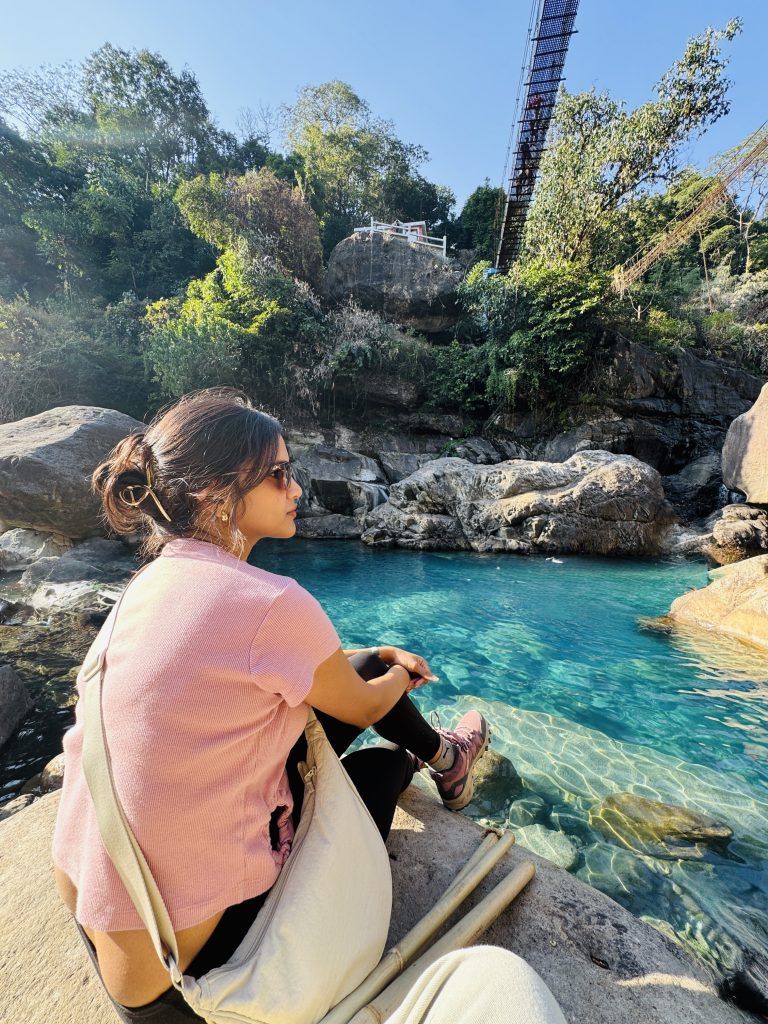
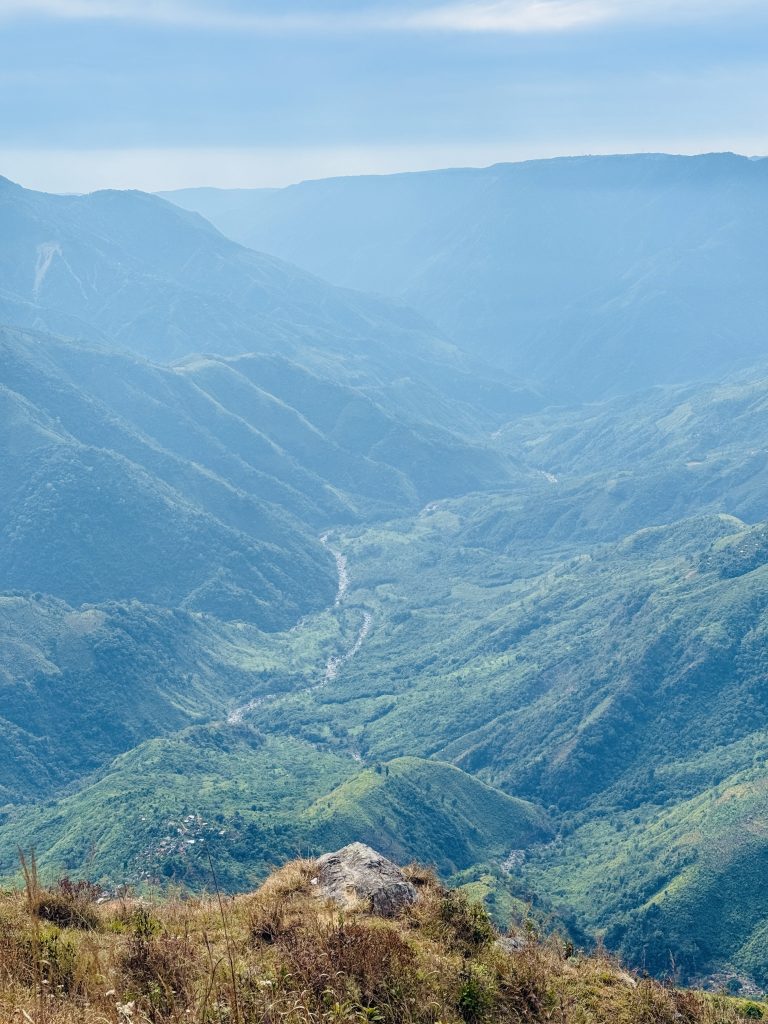
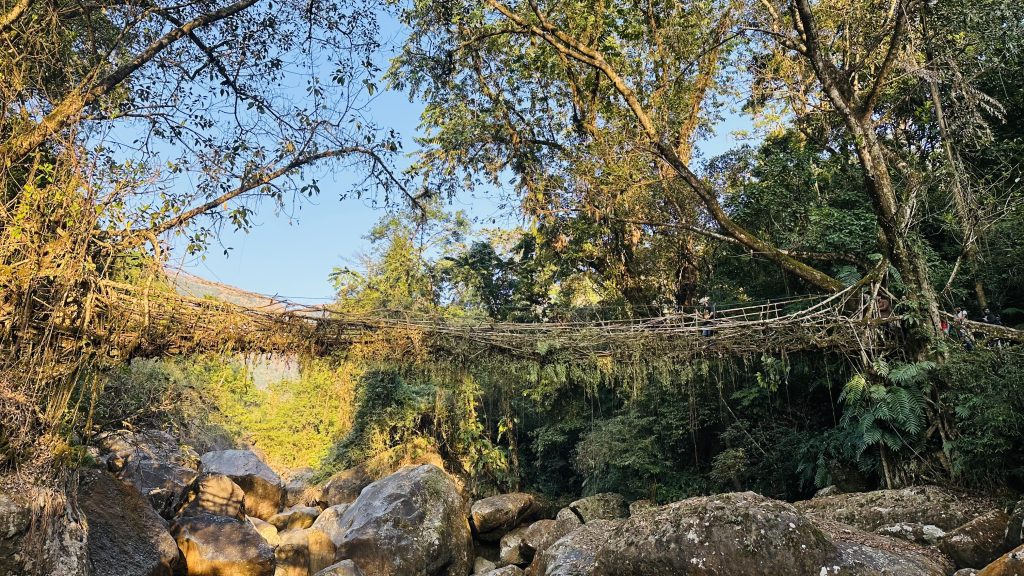
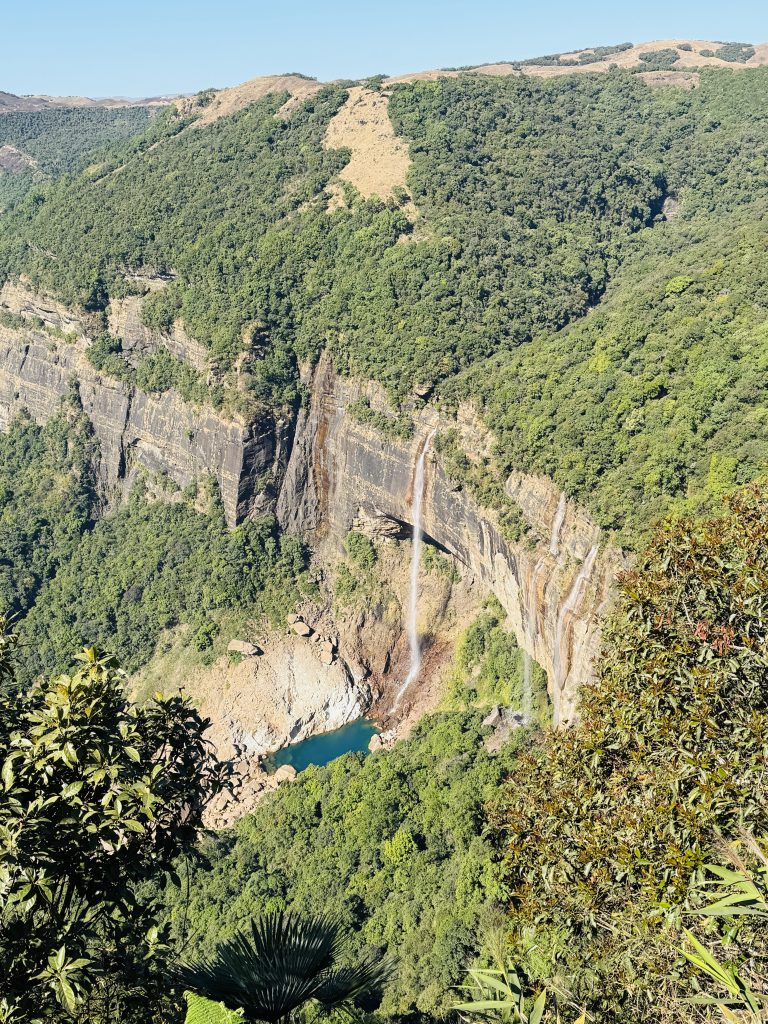
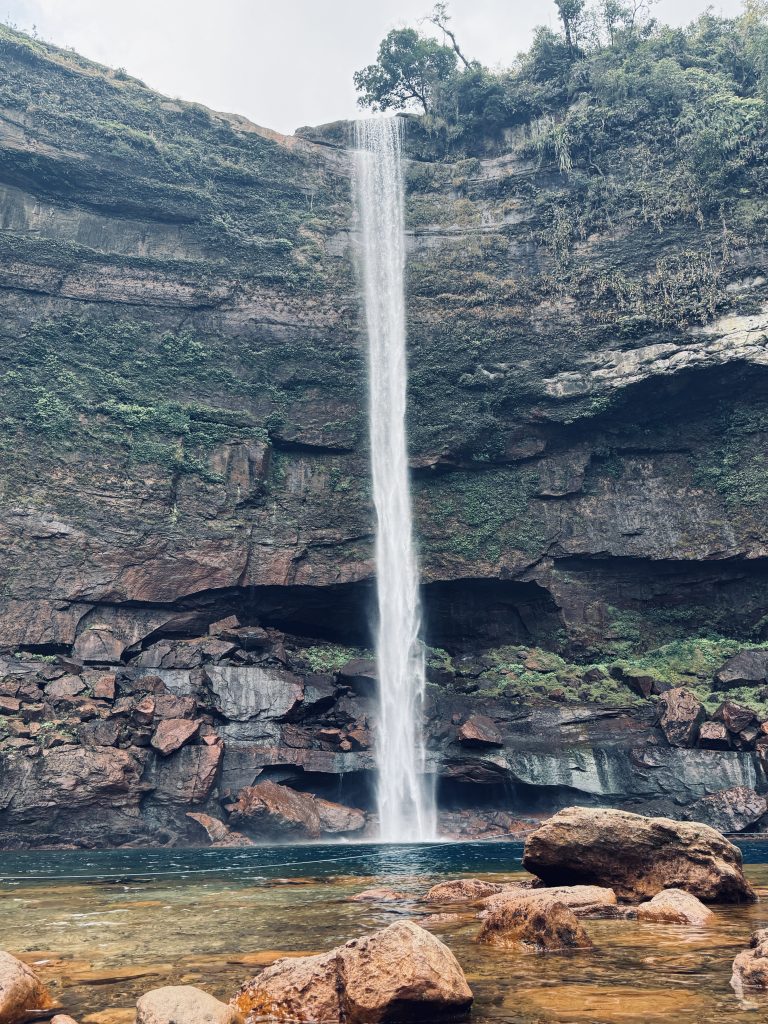
Ready to plan your own trip to this enchanting state? Read on for all the details of my recent adventure and tips to craft your perfect Meghalaya itinerary for 5 days. Explore the best of Meghalaya tourist places and Meghalaya offbeat locations with this blog.
Meghalaya Trip – Itinerary
I booked my Meghalaya trip package through WanderOn community travel and following was their itinerary for 5 days:
- Day 0 – Land in Guwahati, Assam. Drive to Shillong and stay the night
- Day 1 – Visit Laitlum Grand Canyon & Phe Phe waterfall. Drive to Shnongpdeng
- Day 2 – Water activities at Umngot river, visit Mawlynnong. Drive to Cherrapunji
- Day 3 – Hike to Double Decker Bridge, Single Root bridge & Blue Lagoon
- Day 4 – Arwah caves, Nohkalikai waterfall, Lyngksiar waterfall. Drive back to Shillong
- Day 5 – Leave for Guwahati. Visit Umiam Lake. Fly back
Getting to Shillong – The Gateway to Meghalaya
Shillong, the vibrant capital of Meghalaya, is the ideal starting point for exploring the wonders of the state. Here’s how you can reach Shillong conveniently.
By Air
The most accessible route is to fly into Guwahati’s Lokpriya Gopinath Bordoloi International Airport (GAU), located about 120 km from Shillong. From the airport, a scenic drive to Shillong takes approximately 3 to 4 hours, depending on traffic conditions.
Alternatively, Shillong does have a domestic airport at Umroi (Barapani), with limited flight options from Kolkata, Guwahati, and New Delhi. However, flights to Shillong are infrequent, so most travelers prefer Guwahati as their entry point.
By Road
Once in Guwahati, you have several options to travel to Shillong: Private taxis and shared cabs are readily available at the airport and throughout the city. For an affordable and reliable choice, you can opt for ASTC buses, including both standard and air-conditioned options. Alternatively, app-based cabs like Uber and Ola provide a convenient private ride.
Whether you’re flying or driving, the journey from Guwahati to Shillong is a treat, with lush green landscapes and picturesque views to set the tone for your Meghalaya trip.
A Day-by-Day Travelogue
Day 0 – Arrival & First Impressions
I landed at Guwahati Airport around noon and met up with the group I was traveling with. Since I had chosen to travel with the WanderOn community, all our transportation and logistics in Meghalaya were included in the package.
By 12:30 PM, we set off for Shillong. About halfway through the journey, we stopped at Jiva Veg Restaurant in Nongpoh—a delightful spot that’s perfect for lovers of Indian and Chinese cuisine. If you’re traveling this route, this restaurant is a must-visit.
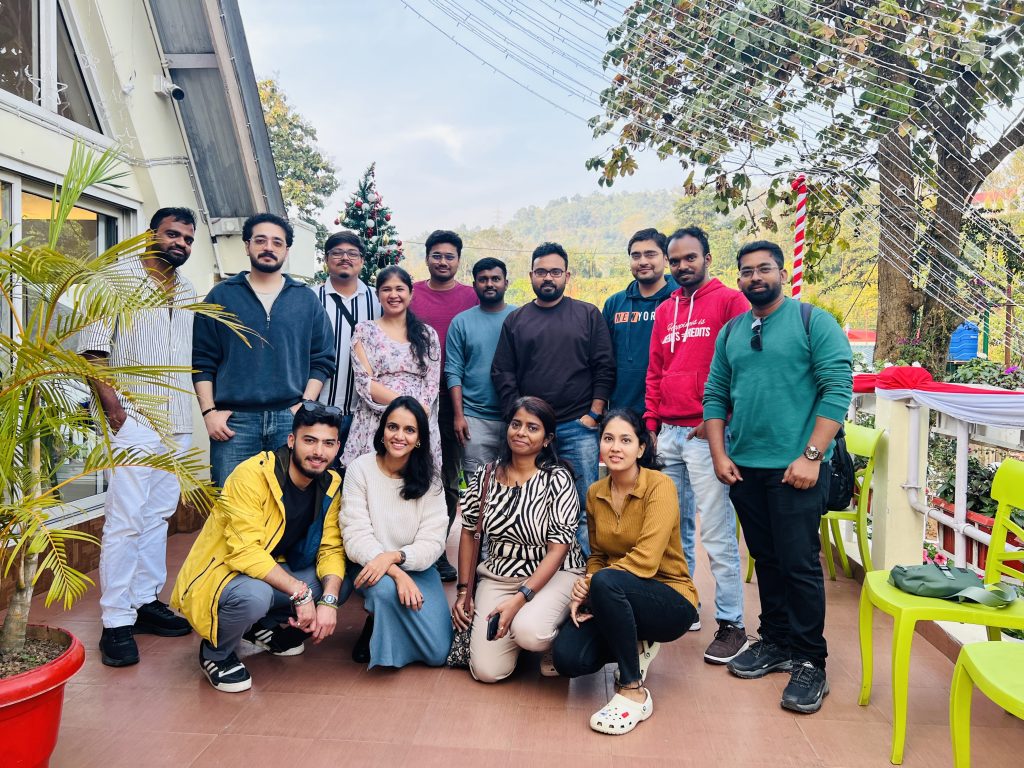
From Nongpoh, Police Bazar, the bustling heart of Shillong, was approximately 1.5 hours away. We arrived in Shillong by 5:30 PM, greeted by the early darkness that’s characteristic of the region. For most of us, adjusting to the early sunsets and equally early mornings was an exciting shift from our usual routines.
The evening was spent soaking in the lively vibe of Police Bazar. We wandered through its vibrant markets, indulging in delicious momos from street vendors and savoring local specialties. For dinner, we explored some fantastic restaurants, including Kim Pou (for authentic Chinese), Jiva Veg (for vegetarians), Madras Café (for South Indian flavors).
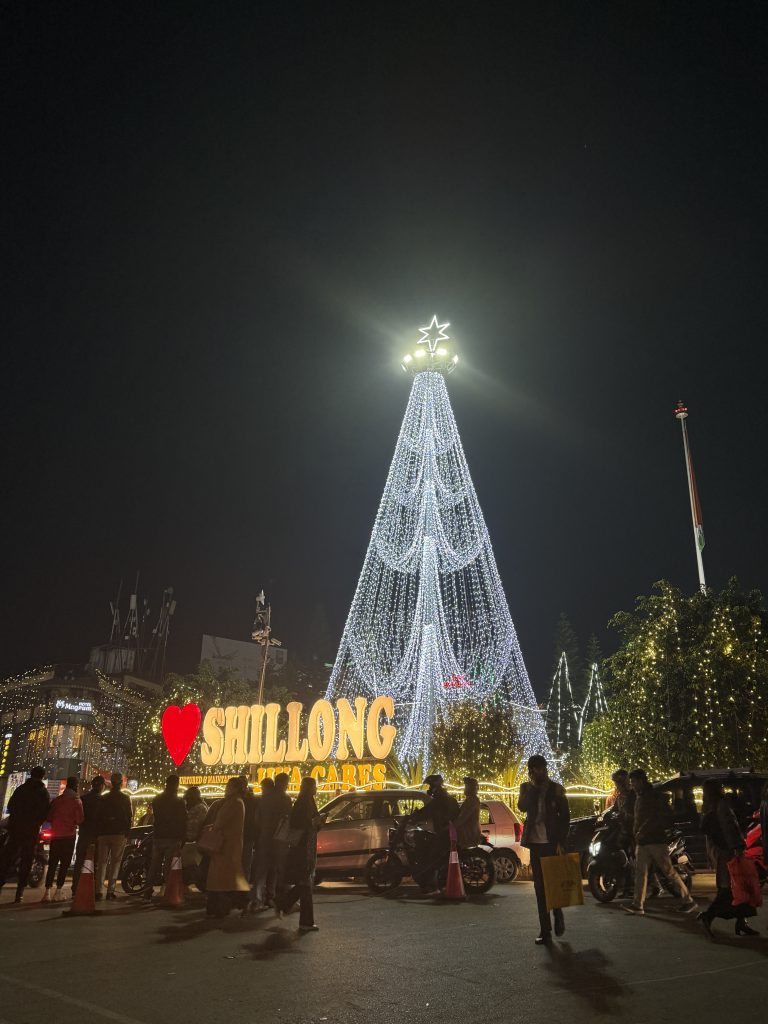
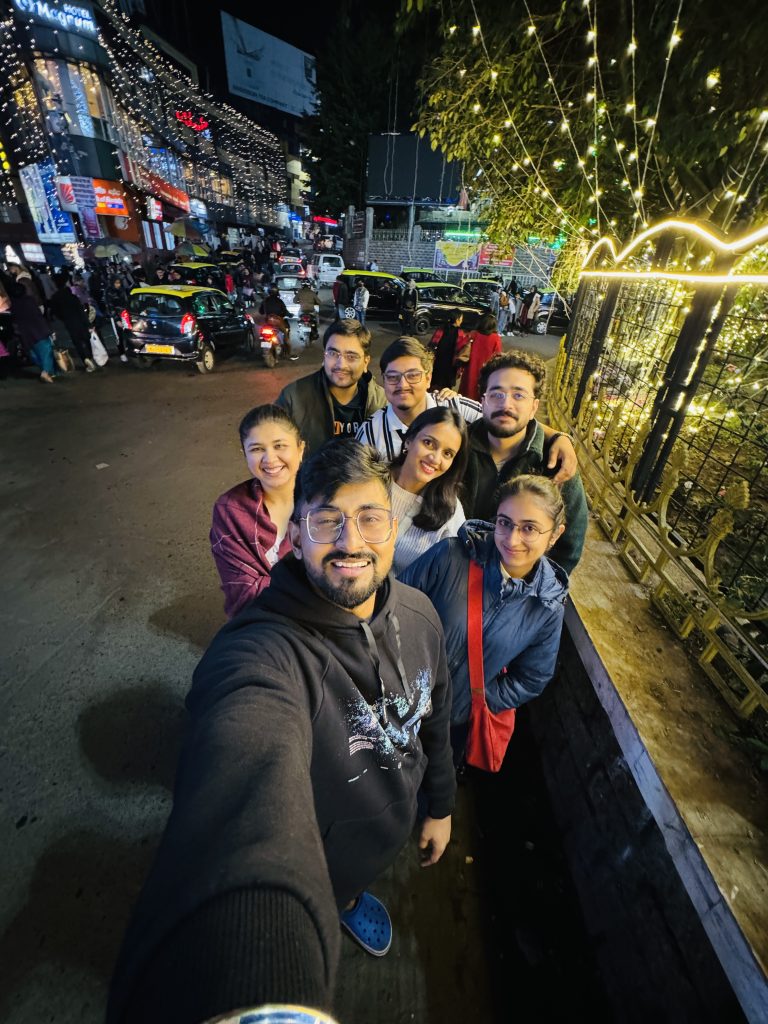
With bellies full and spirits high, we wrapped up the day, eager for the adventures ahead.
Day 1 – Immersing in Meghalaya’s Natural Wonders
Laitlum Grand Canyon
Our day began with a visit to the majestic Laitlum Grand Canyon, located in the East Khasi Hills. True to its name, Laitlum, which means “end of hills” in Khasi, this awe-inspiring spot offers breathtaking panoramic views of the Khasi, Jaintia, and Garo hills. Situated around 26 km from Shillong (approximately a 1-hour drive), the canyons are a haven of serenity and grandeur. We spent time soaking in the tranquility, marveling at the expansive landscapes, and capturing the stunning vistas in our cameras and hearts.
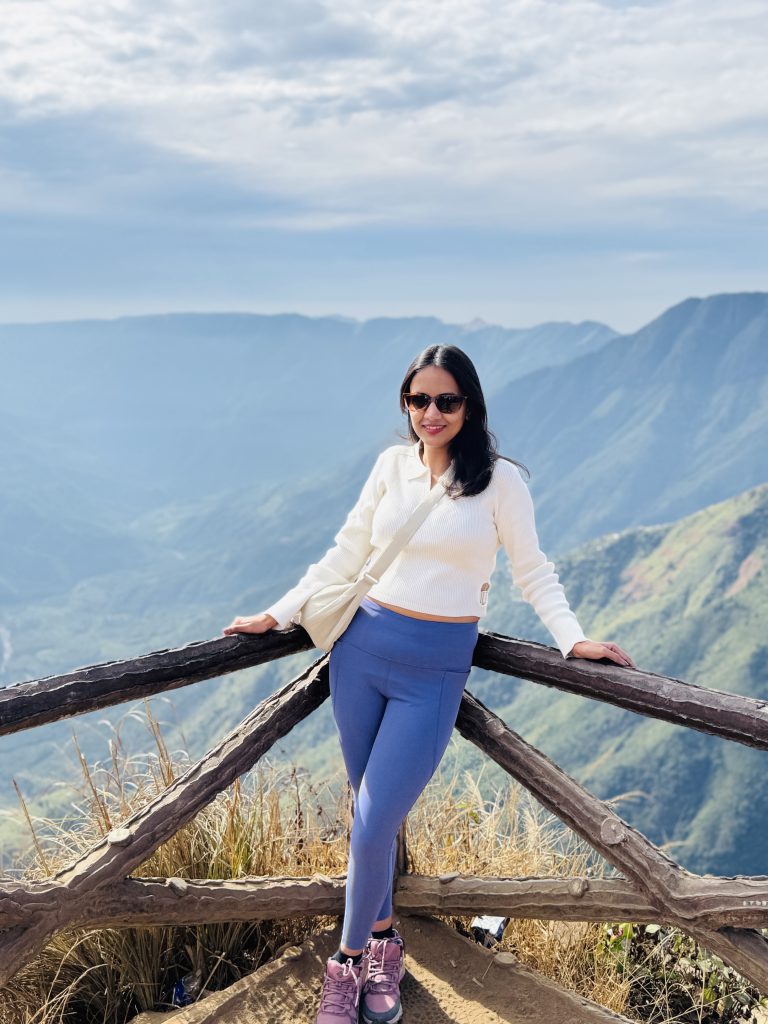
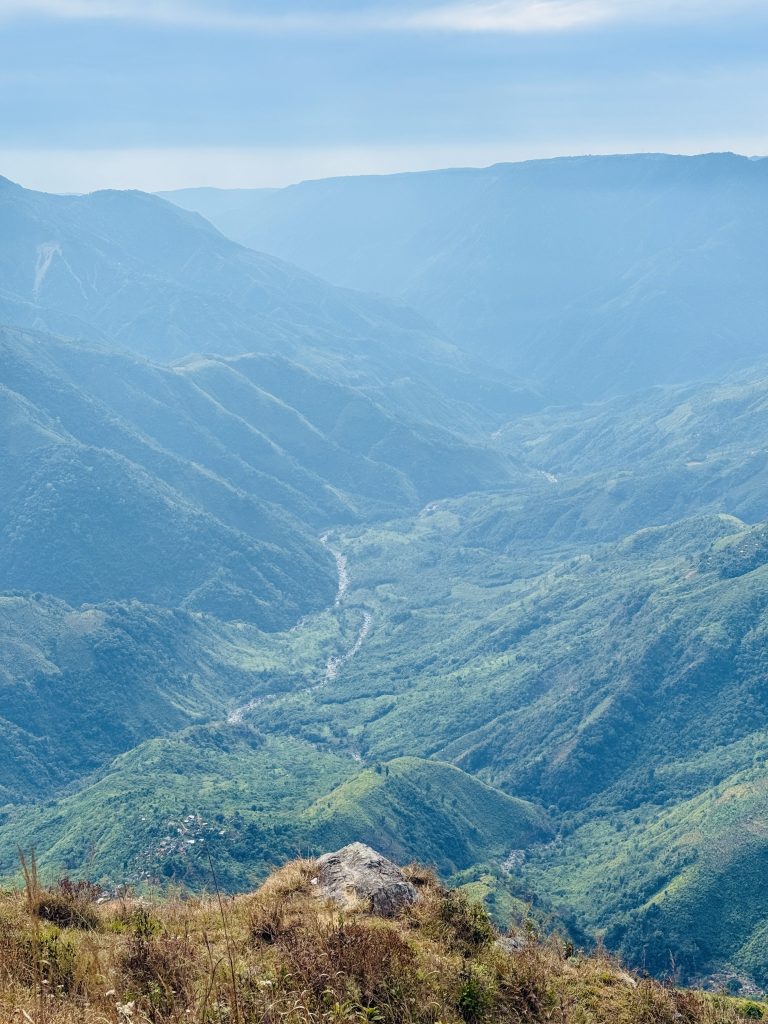
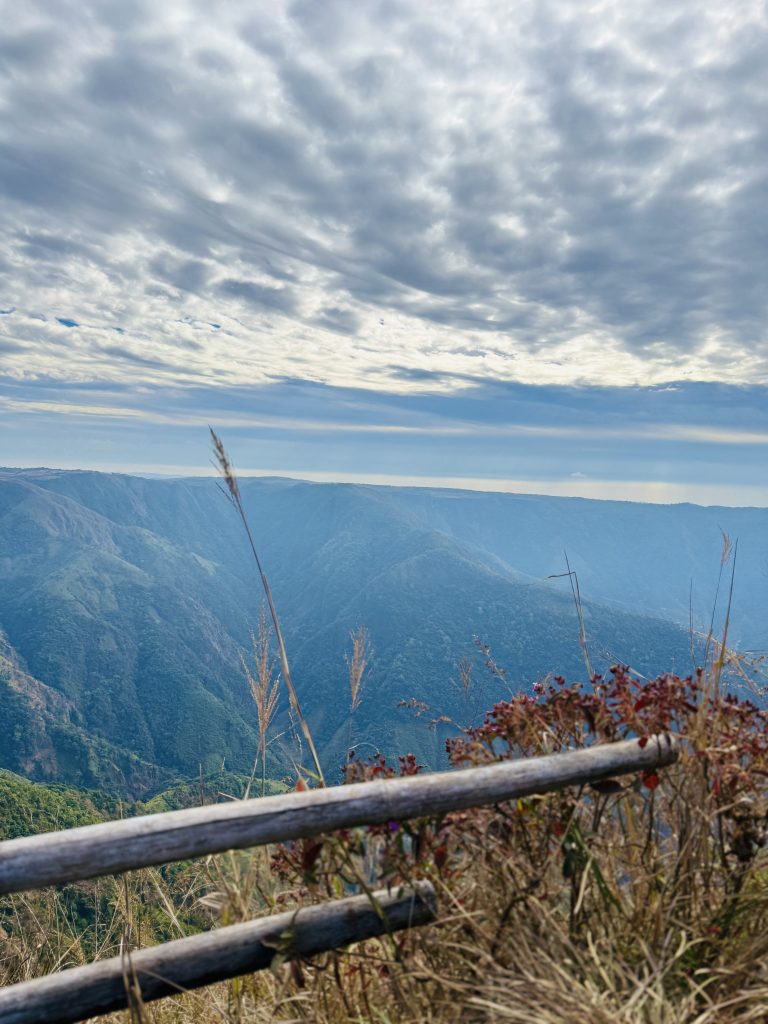
Phe Phe Waterfalls
Our next stop was the stunning Phe Phe Waterfalls, located in Shkentalang Village, near Jarain in the West Jaintia Hills District, about 88 km (a 3-hour drive) from our last destination. We arrived at a small eatery near the falls for a quick lunch before embarking on the journey to the waterfall. To reach the falls, we took shared boats across a serene river (Rs50 per head), followed by a short walk and a downhill trek through expansive meadows and bamboo plantations.
After about 15 minutes, we arrived at the mesmerizing two-tiered Phe Phe Falls. From the base, the first tier is visible, with towering cascades plunging into a crystal-clear blue pool, embodying its name “Phe Phe,” meaning Paradise in the local Jaintia dialect. For those wanting to dip in, there are bamboo changing rooms and life vests available for a small rental fee. Although we didn’t take the plunge, we enjoyed the beauty of the falls, clicked some pictures, and soaked in the serenity.
Afterward, we made our way back up, climbing 200–300 steps, and as we reached the riverbank, the sun had set, casting a dusky glow on the landscape.
Here is a complete guide to Phe Phe Falls, with all the details you need to plan your perfect trip!
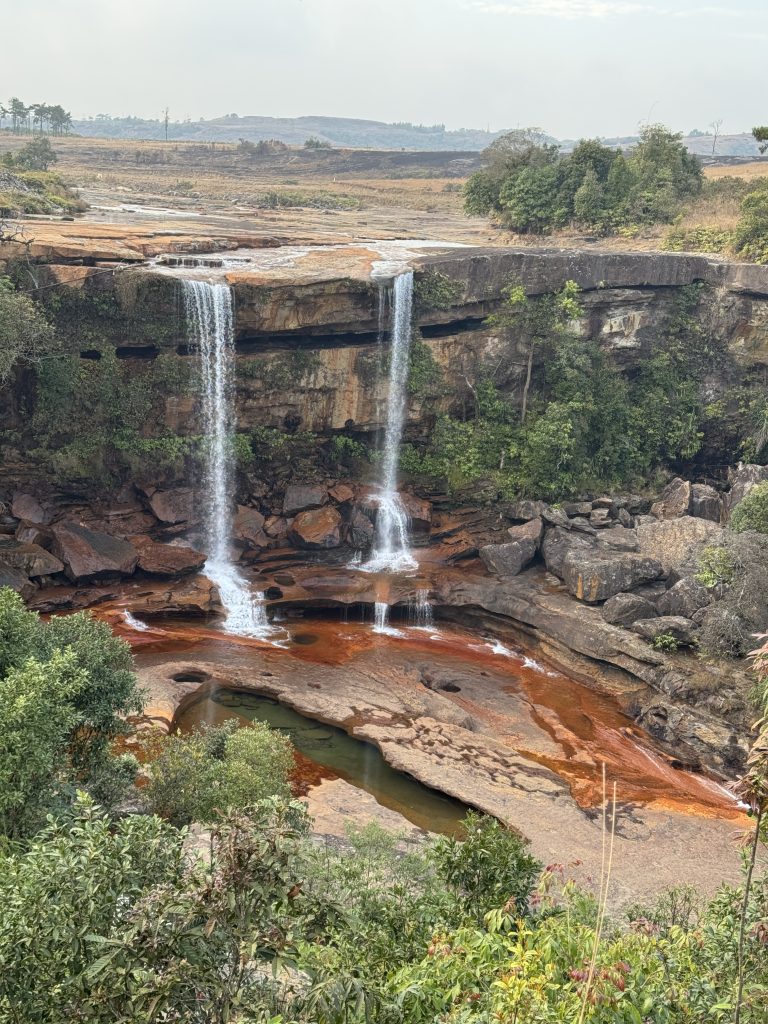
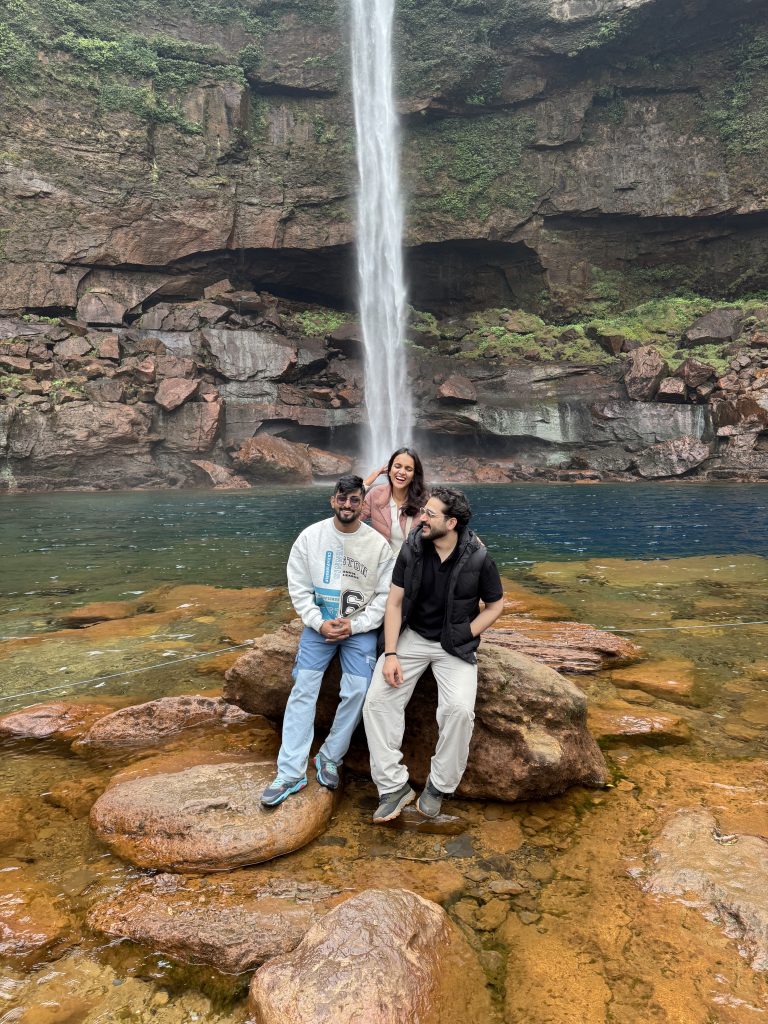
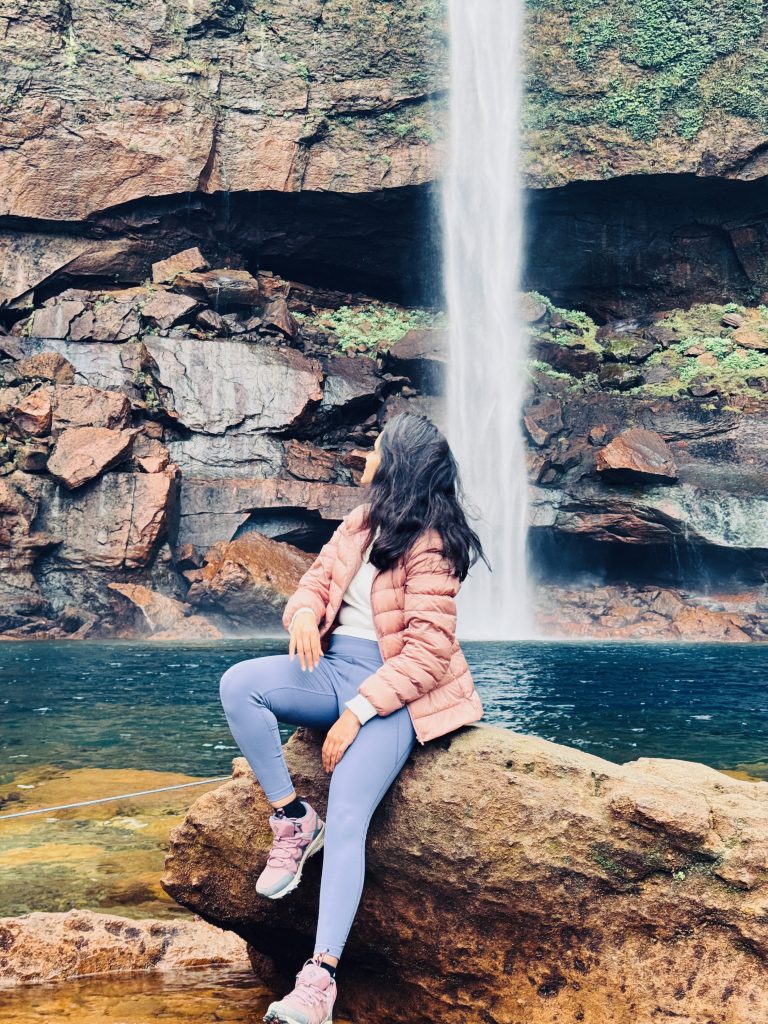
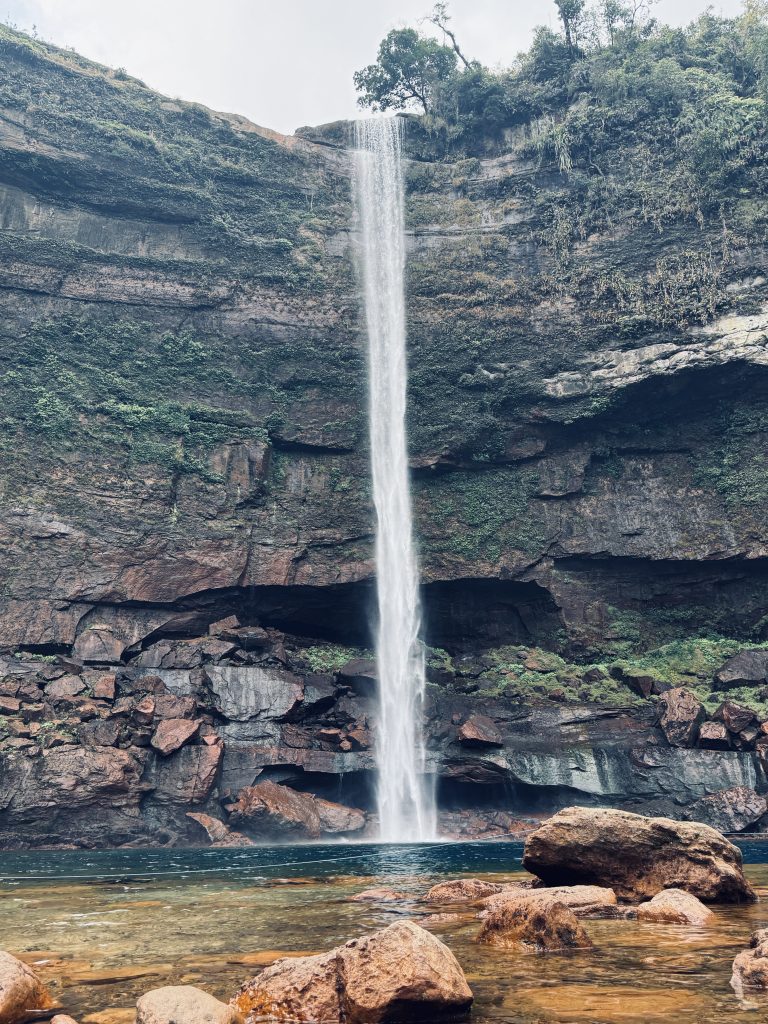
Shnongpdeng
After leaving Phe Phe Falls around 7 PM, we drove 45 km (about 1.5 hours) to the serene village of Shnongpdeng. Known for its crystal-clear waters and tranquil ambiance, Shnongpdeng was our resting spot for the night.
Our alpine tents were ready, and the evening unfolded beautifully with a hearty dinner, a lively bonfire, and soulful music under the starry sky. It was the perfect end to a day filled with adventures, setting the tone for the explorations to come.
Day 2 – A Day of Water Adventures and Cultural Exploration
Exploring Umngot River
Before diving into the details of our day, here’s some helpful information about the region: Dawki and Shnongpdeng are the two primary towns where visitors can find accommodations like homestays and alpine tents. While Dawki tends to be more crowded and bustling, Shnongpdeng offers better options in terms of quality and ambiance. If you’re staying in tents, you’ll use either attached or common washrooms. Fortunately, the shared facilities during our stay were clean and well-maintained, with additional washbasins available along the streets for convenience.
We woke up to a stunning morning with clear blue skies perfectly reflected in the crystal-clear waters of the Umngot River. Often regarded as one of the cleanest rivers in India, its transparent waters create the illusion of boats floating in mid-air. Umngot river is one of the best places to visit in Meghalaya in December (generally winter months – October to February) to experience the river in all its pristine beauty.
Our day began with a serene boating experience in traditional country boats that rowed upstream to the source of the river. The breathtaking scenery along both banks, with lush greenery and dramatic rock formations, made every moment unforgettable.
On our return, we stopped midway to indulge in a series of thrilling water activities, including Cliff Jumping, Kayaking, Snorkeling, Ziplining. The charges for these activities range between ₹300–₹500 per person. After an exhilarating time, we headed back to our tents to freshen up and prepare for the next leg of our journey.
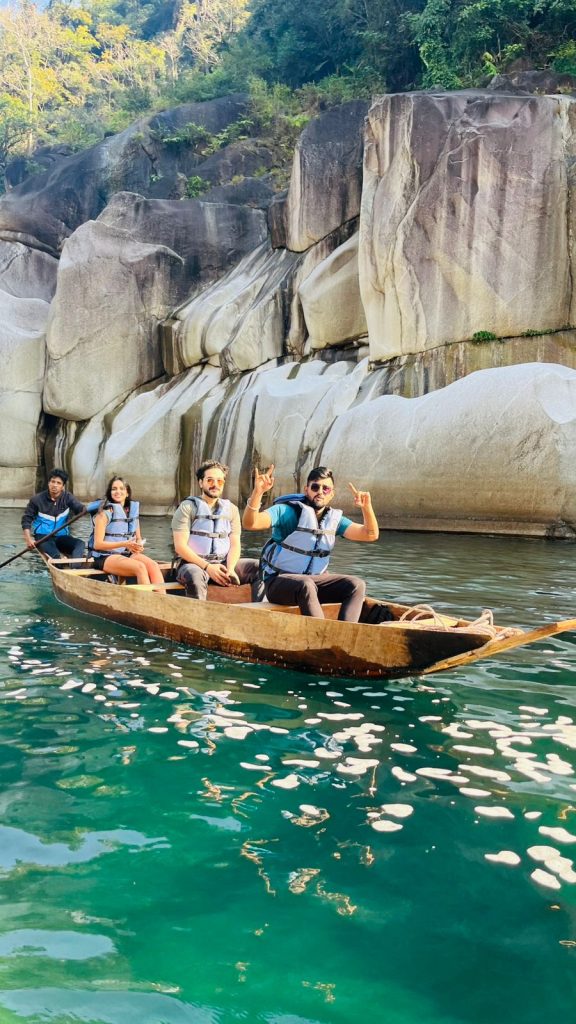
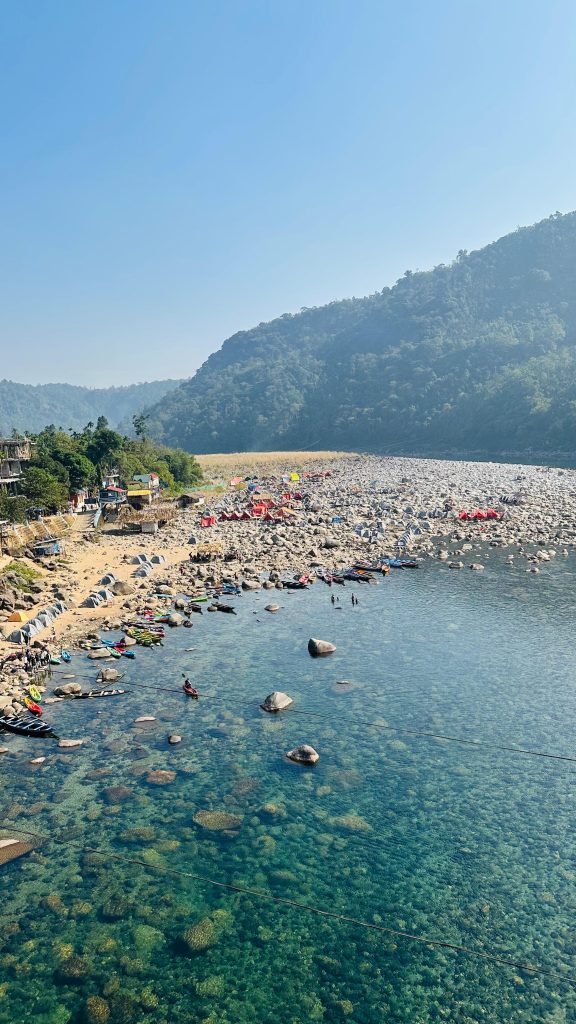
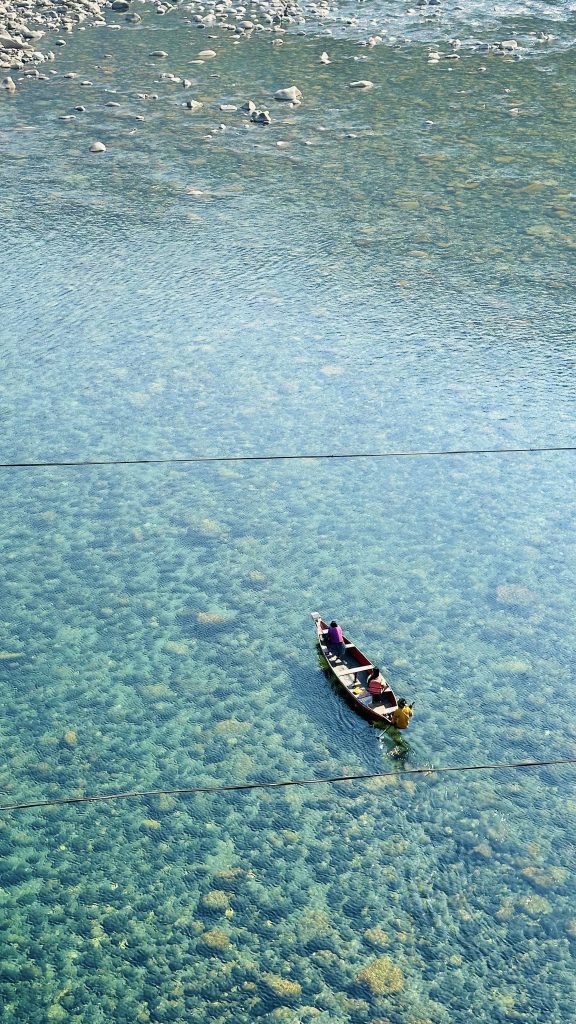
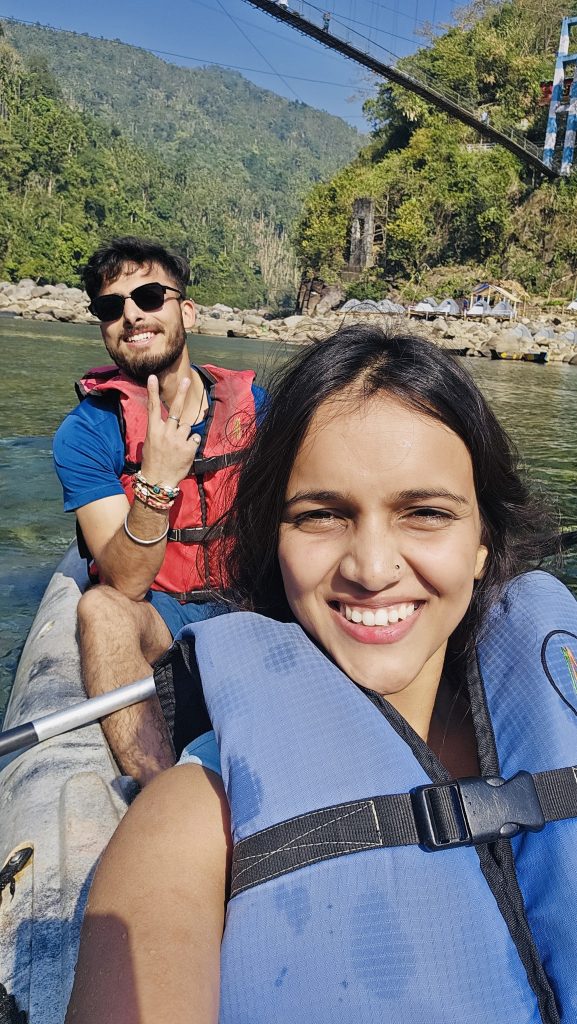
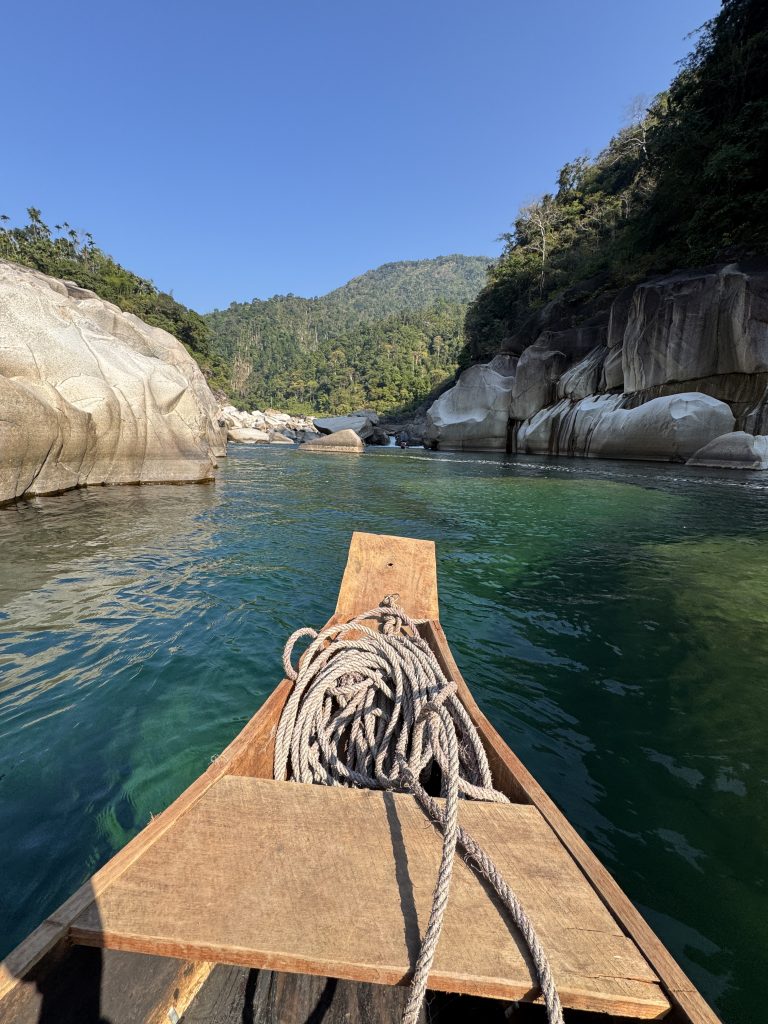
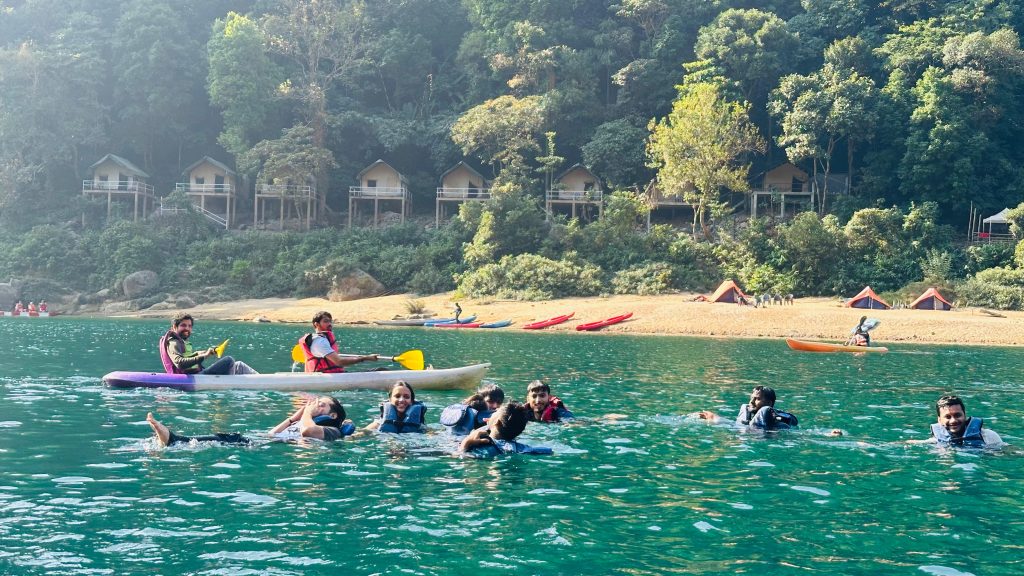
Mawlynnong
Our next destination was Mawlynnong, a picturesque village located about 40 km (1.5 hours) from Shnongpdeng. Renowned as Asia’s Cleanest Village byDiscover India, Mawlynnong lives up to its title with its spotless streets, bamboo dustbins, and lush greenery.
We spent an hour wandering through the well-kept pathways, admiring the vibrant plants and flowers that enhanced the village’s charm. A highlight was visiting the Sky Viewpoint (₹30 per person), a bamboo structure that offers panoramic views of the village and the surrounding landscapes. Watching the sunset from this vantage point was an absolute treat.
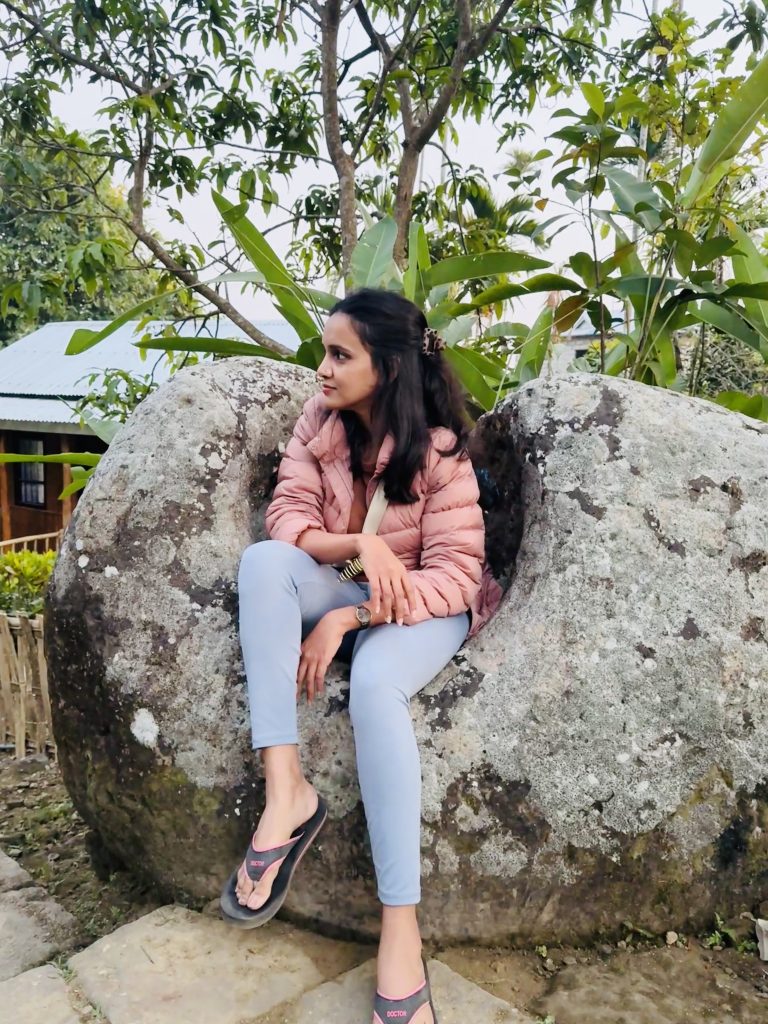
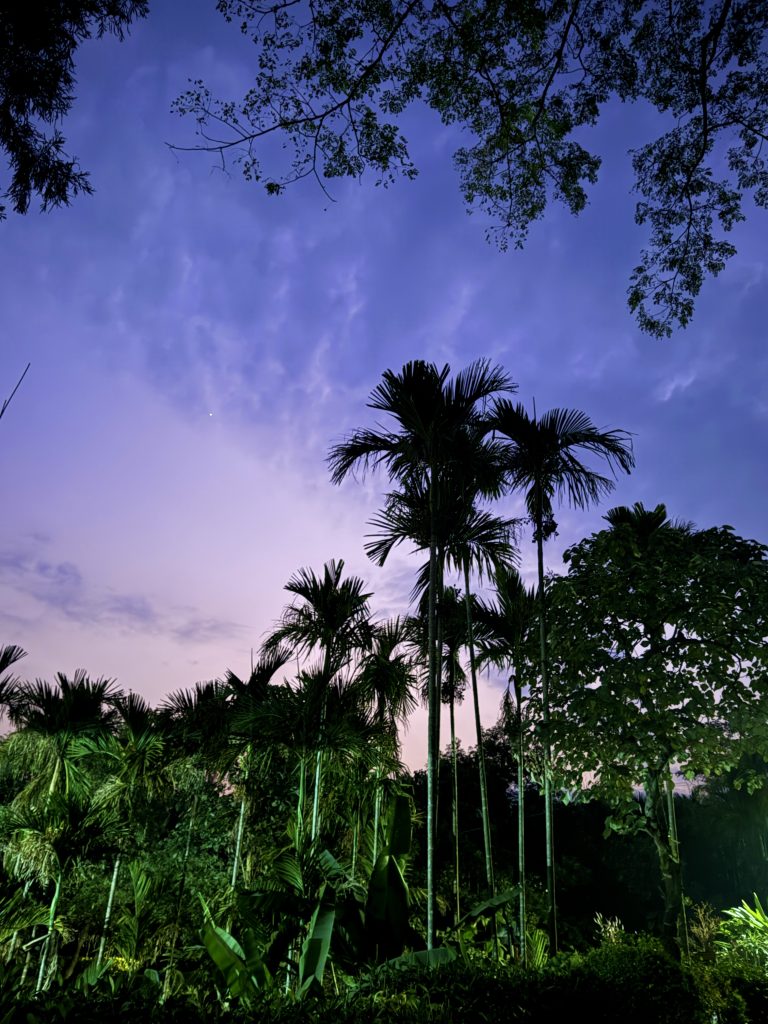
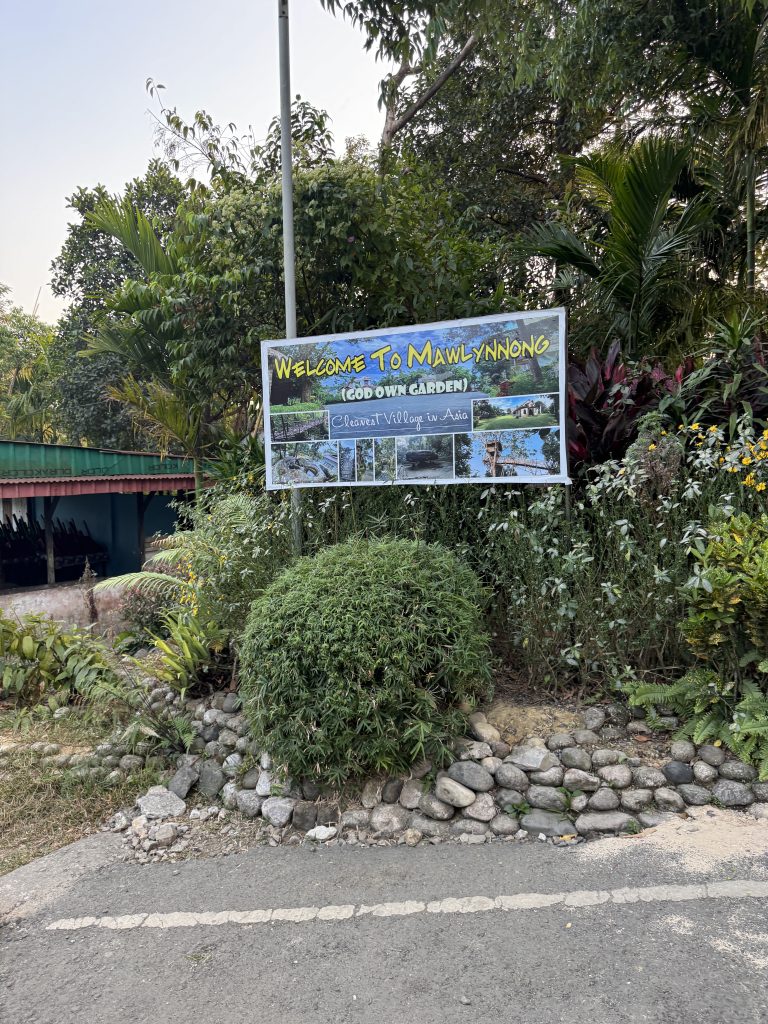
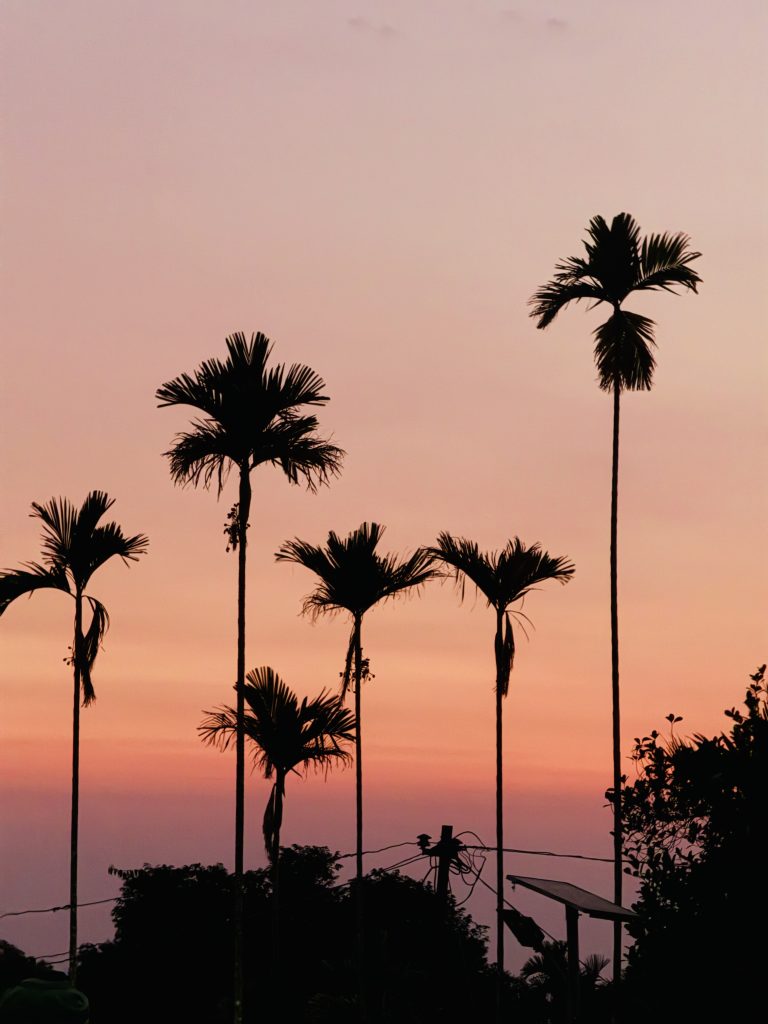
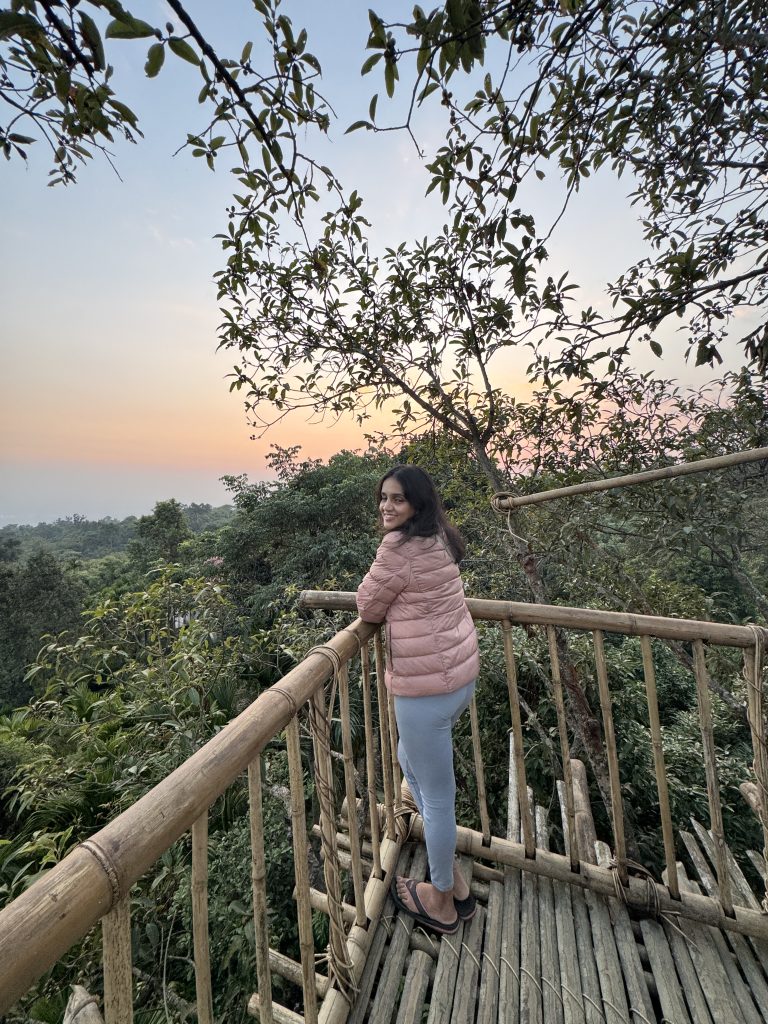
Drive to Cherrapunji
As the sun set, we departed from Mawlynnong around 6 PM, embarking on an 80 km (2.5-hour) drive to Cherrapunji, our base for the next two days.
Day 3 – The Day of Marvelous Living Root Bridges
We started the day early with fresh sunshine and a delicious breakfast at our Cherrapunji stay. Our trip captains aptly called it the “D-day” of the Meghalaya itinerary. One of the best places to visit in Meghalaya, we were set to explore the most iconic—Living Root Bridges.
Mawsmai Caves
Our first destination was the Mawsmai Caves, located about 6–7 km from Cherrapunji (or Sohra, as the locals call it). Meghalaya is known for its fascinating caves, with nine out of India’s ten longest and deepest caves located in the state. Mawsmai Caves are a highlight, showcasing unique stalactite and stalagmite formations created over millennia by limestone erosion and flowing water.
Navigating through the caves can be tricky as the passage narrows in places, but the well-lit interiors make the experience safe and enchanting. Entry fees are Rs20 per head, and the caves are open from 9:30 AM to 5:30 PM.
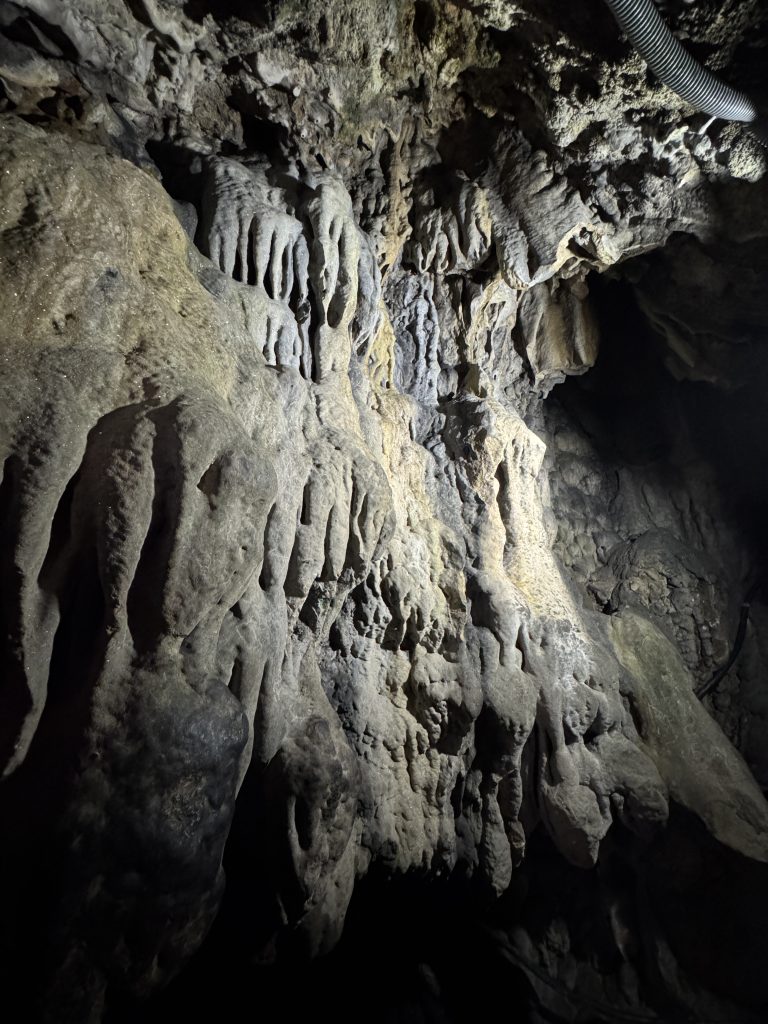
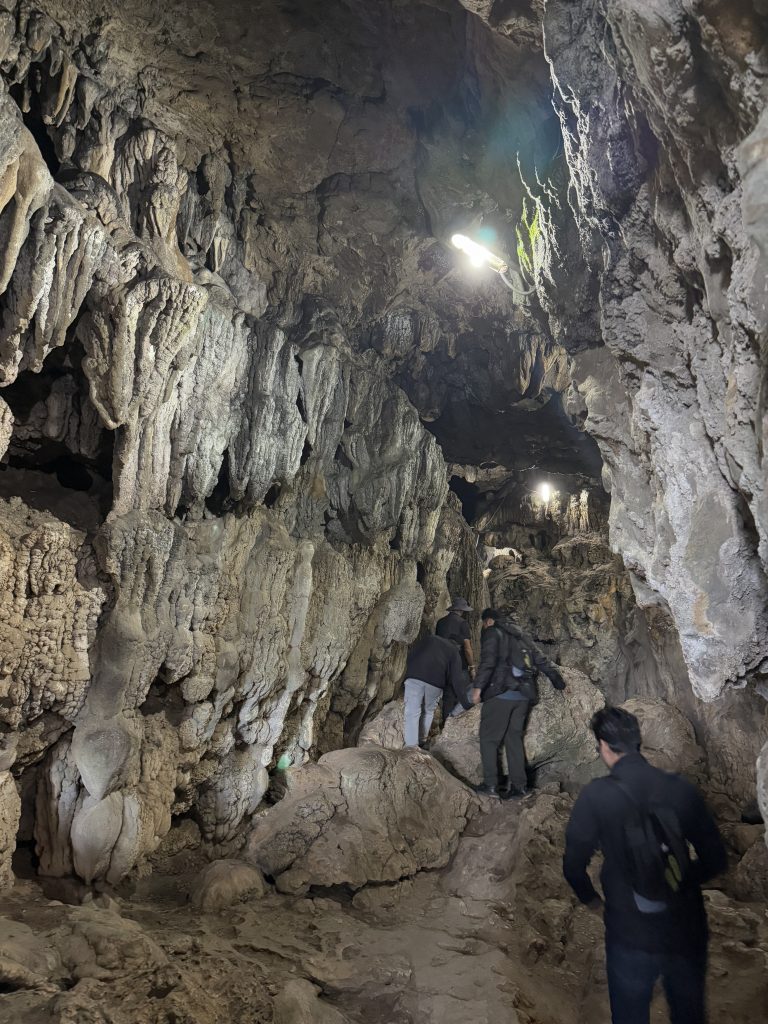
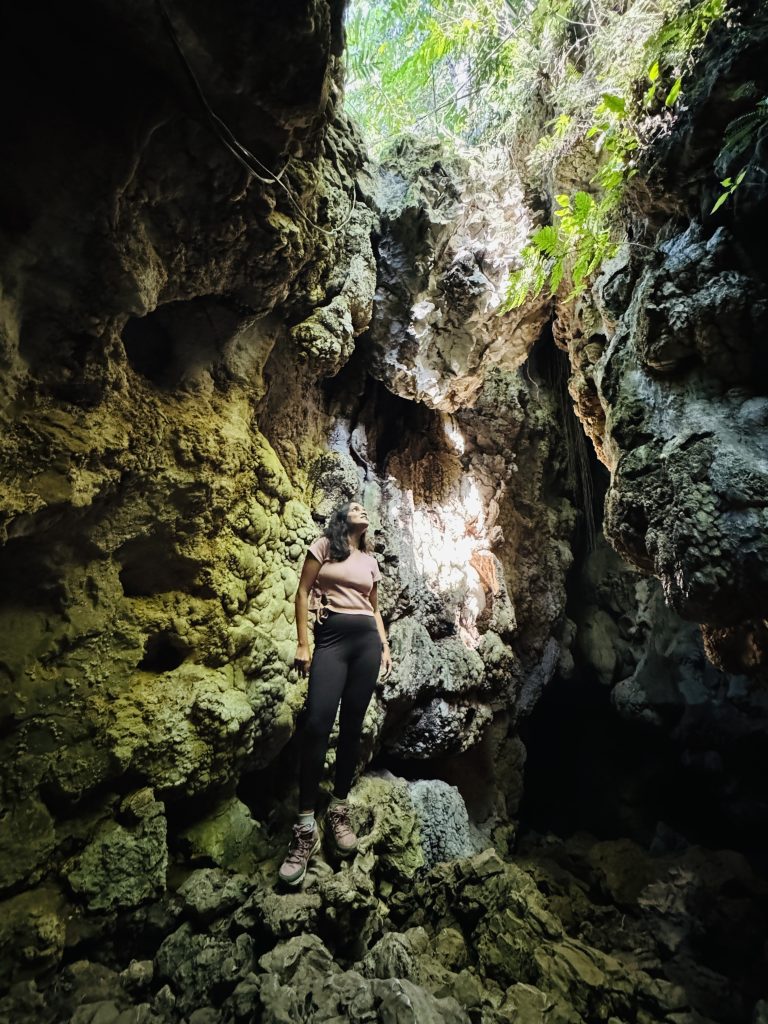
Trekking to Living Roots Bridge
After a 30-minute drive, we arrived at Tyrna Village, the starting point for the trek to the Living Root Bridges. These bridges, carefully grown over decades by the Khasi and Jaintia tribes using the aerial roots of rubber trees, are a UNESCO World Heritage Site.
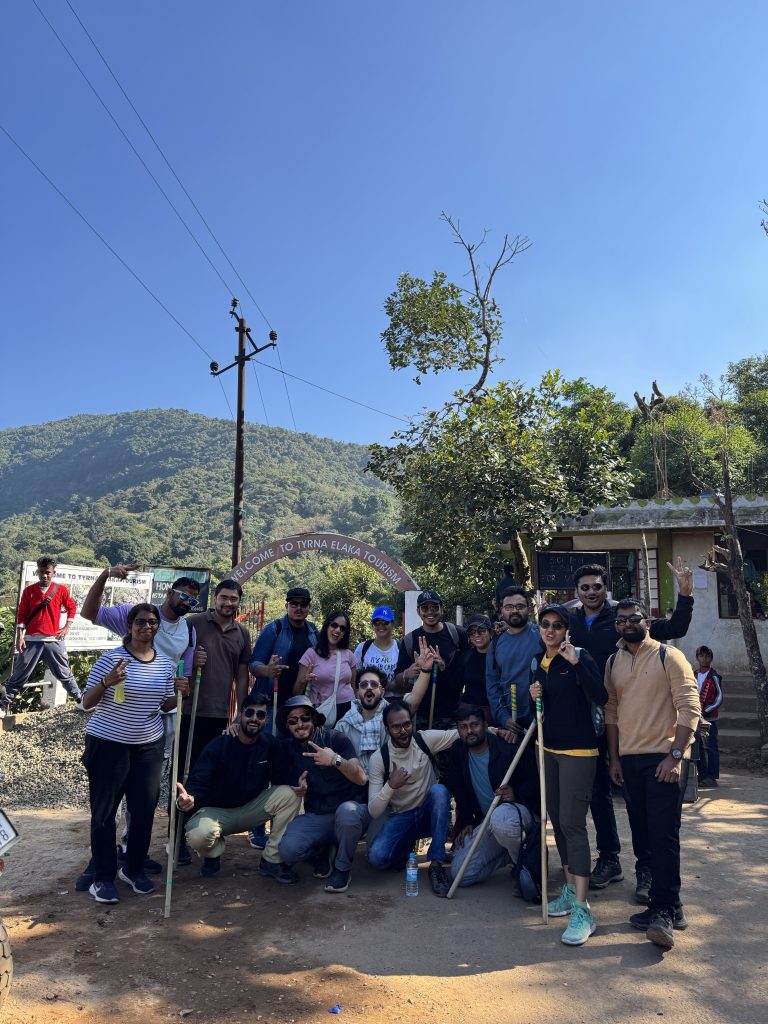
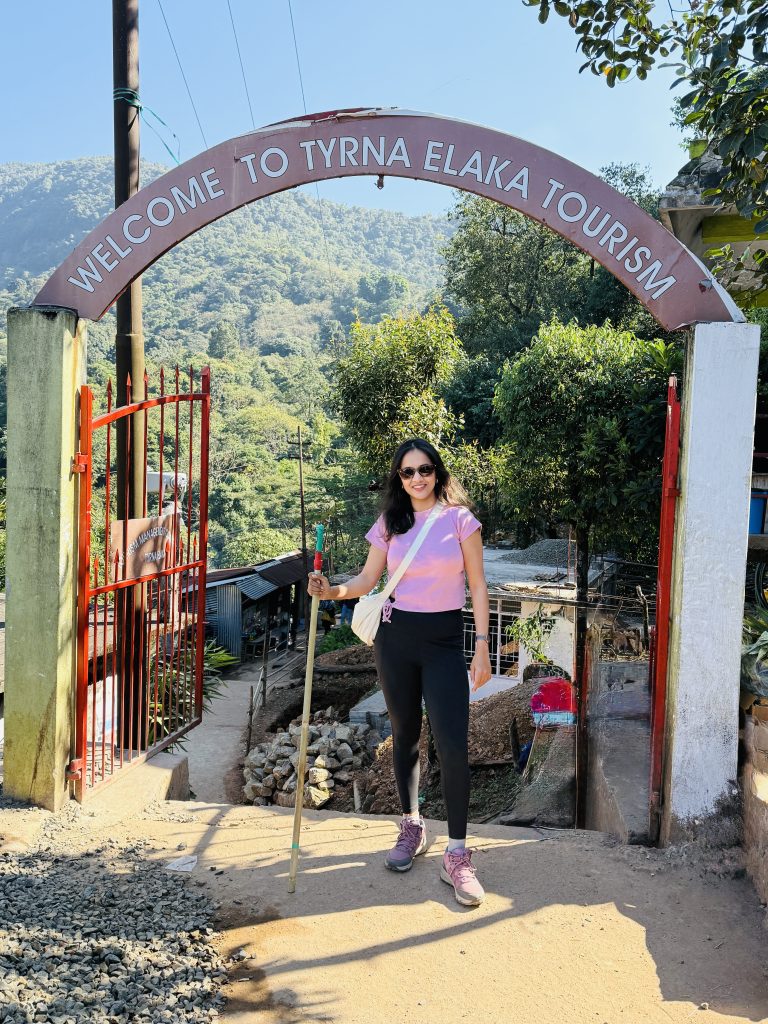
Double Decker Living Root Bridge
The trek to the Double Decker Root Bridge in Nongriat is both challenging and rewarding, starting with a steep descent of about 3,500 steps. Along the way, small shops sell snacks and bamboo walking sticks (Rs20 each). Though I’m not a fan of trekking poles, I decided to get one, anticipating its usefulness during the return climb. Local boys offered to guide us, but the path is clearly marked, making a guide unnecessary.
Halfway through, we reached Nongthymmai, the midpoint of the trek. Here, a diversion leads to a Single Root Bridge, which we decided to visit later, and continued our journey toward the Double Decker Bridge. Soon after, we came across a suspension bridge offering breathtaking views of a crystal-clear river below. The bridge was shaky, but the blue waters beneath were exactly as depicted in pictures.
About 5-7 minutes later, we encountered a lesser-known living root bridge, which felt like a preview to the main attraction. After crossing another ticket counter at Nongriat, the Double Decker Bridge finally came into view, standing proudly over the river. Despite the crowds, we managed to capture beautiful photos and enjoy the bridge’s charm. Nearby shops served Maggi, momos, and tea, which we savored while dipping our feet in the cool river water, with fish nibbling at our feet for an impromptu pedicure!
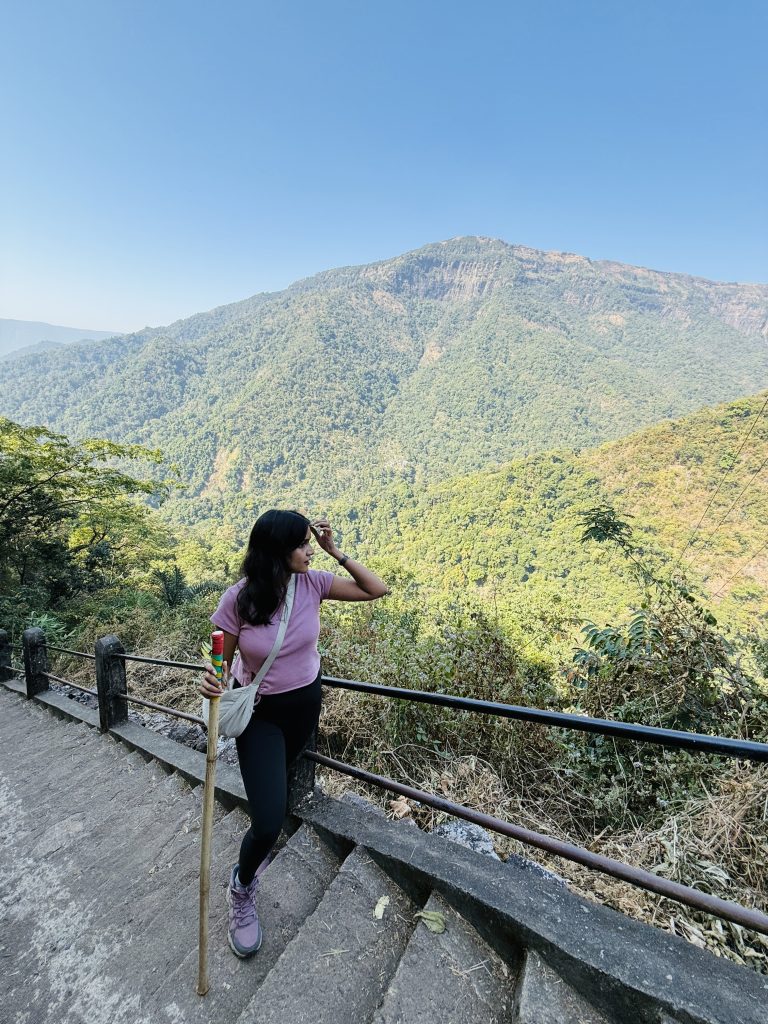
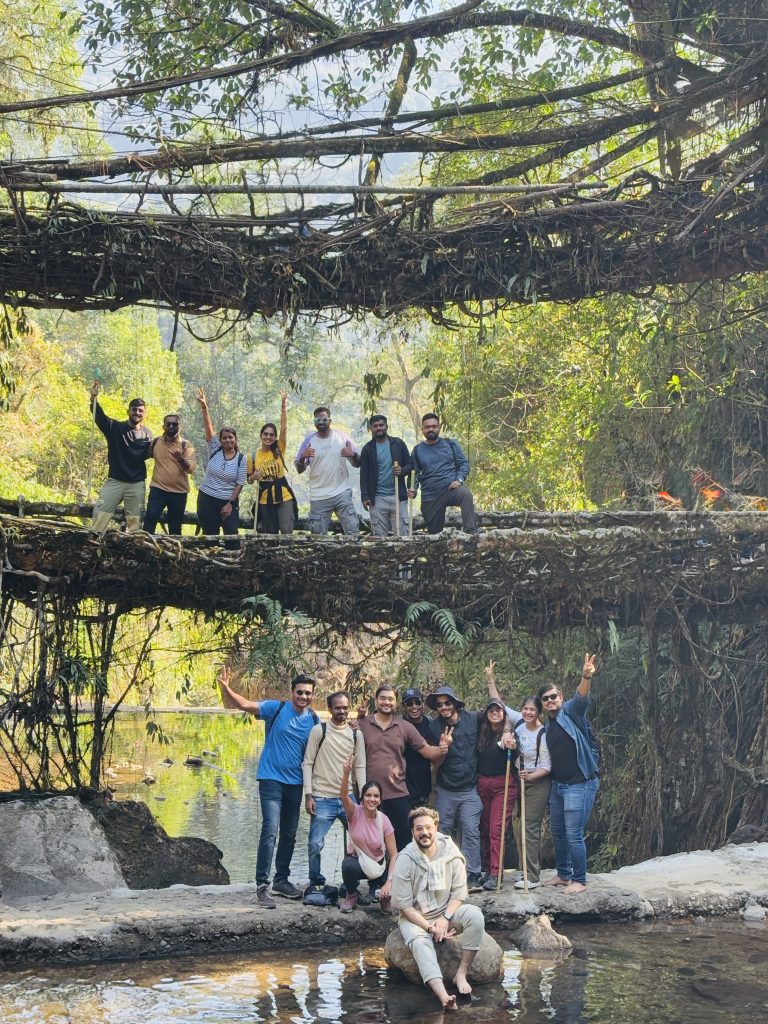
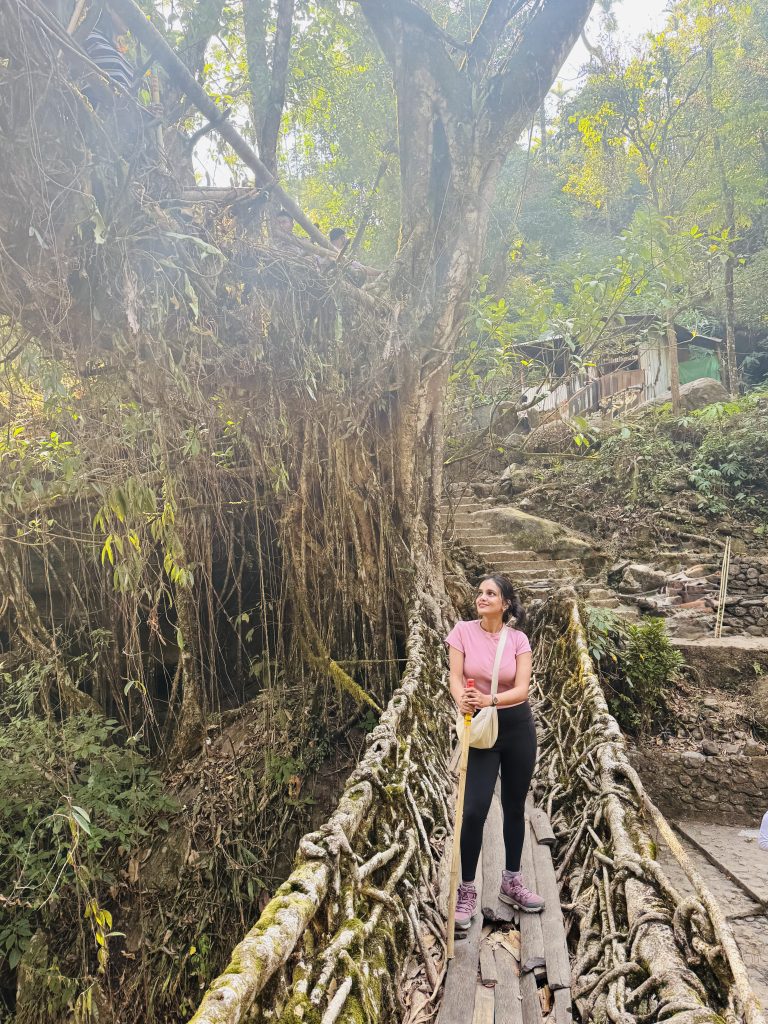
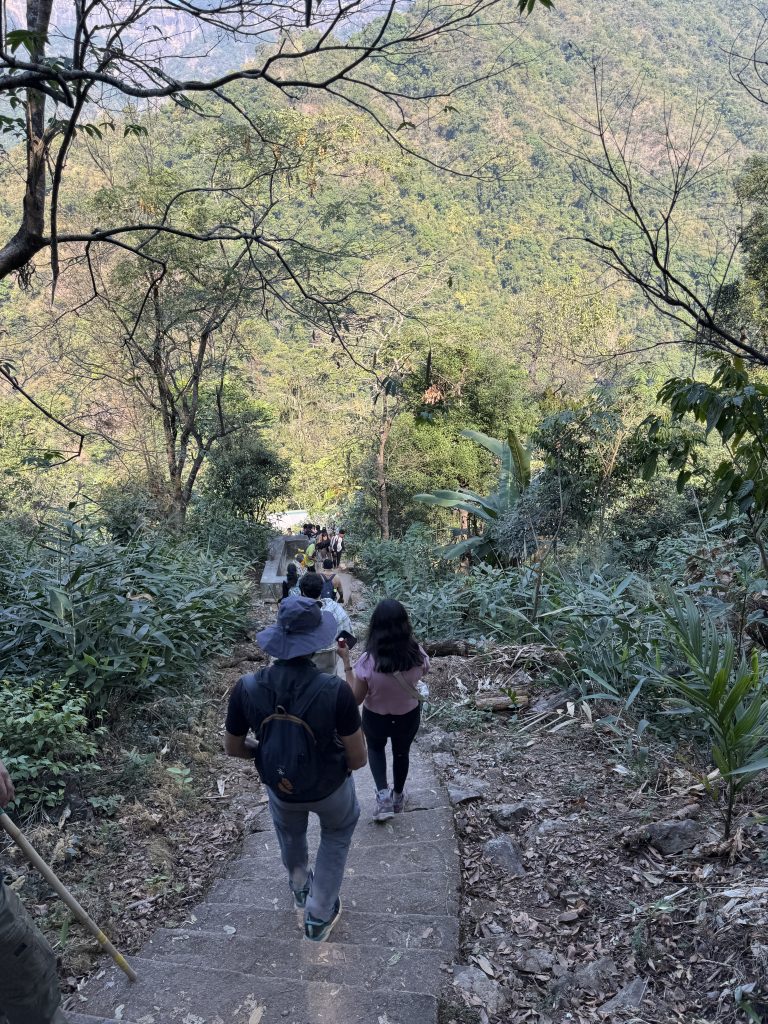
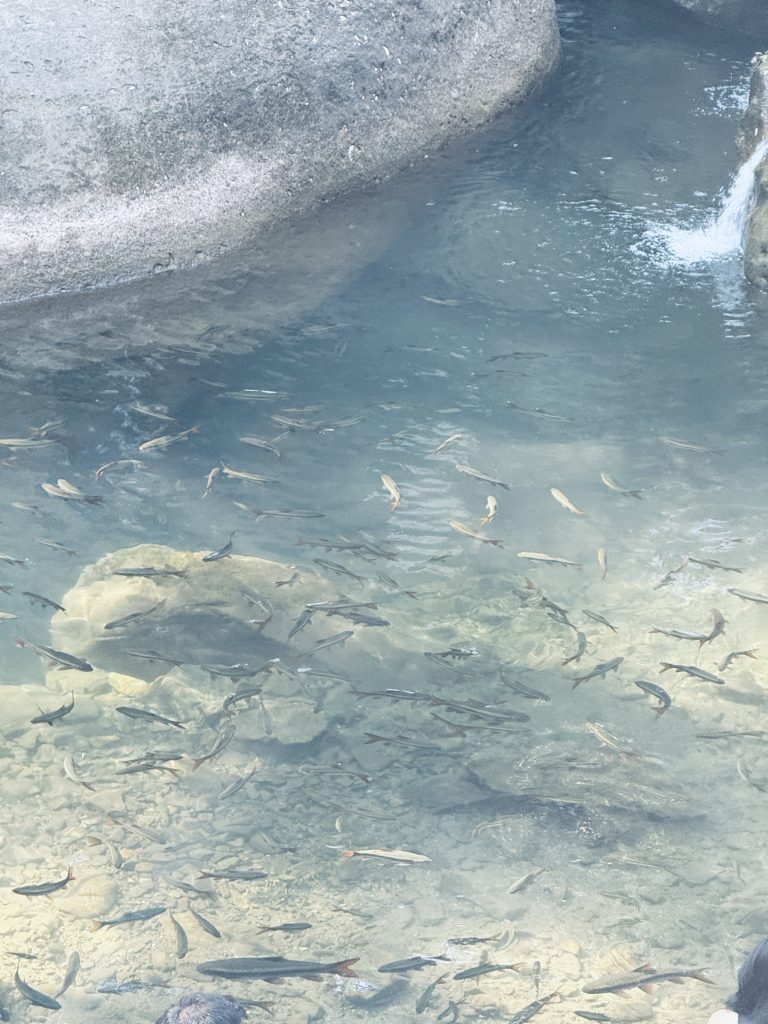
Blue Lagoon
On our way back, we made a stop at the Blue Lagoon, located just below the iron suspension bridge. The view was mesmerizing—the water’s vibrant blue hue needed no enhancement or filter, a natural masterpiece.
While a few adventurous visitors were taking refreshing dips in the lagoon, we opted to sit back and soak in the tranquility. It was the perfect opportunity to rest, recharge, and marvel at the stunning surroundings before continuing to our next destination.
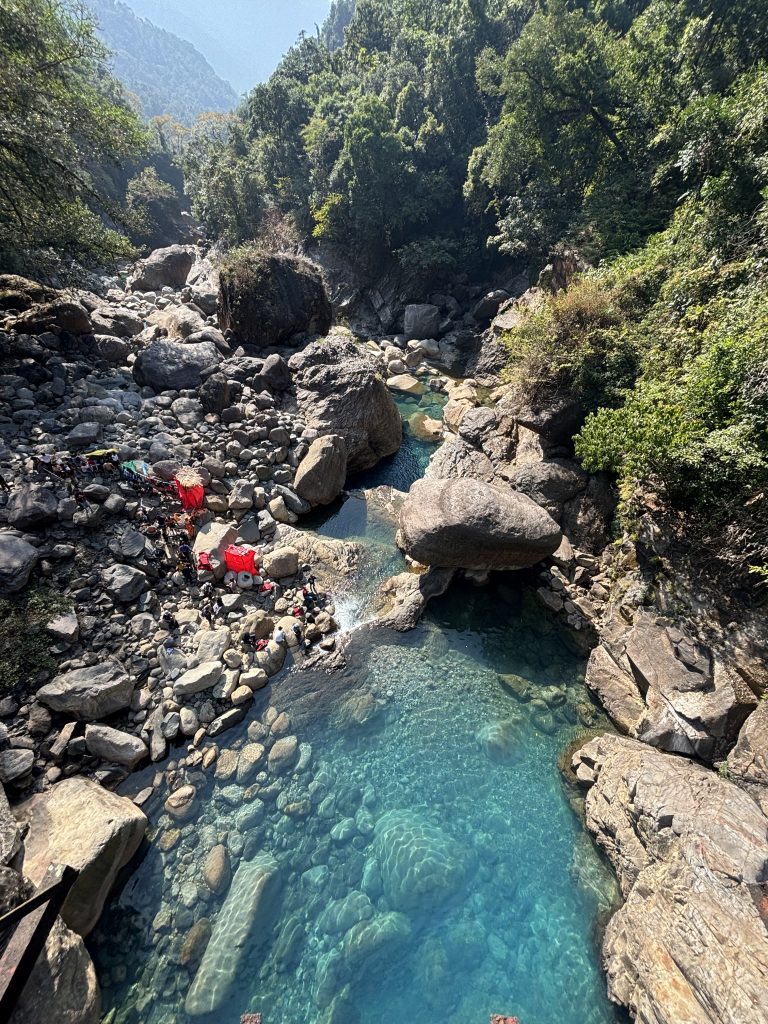
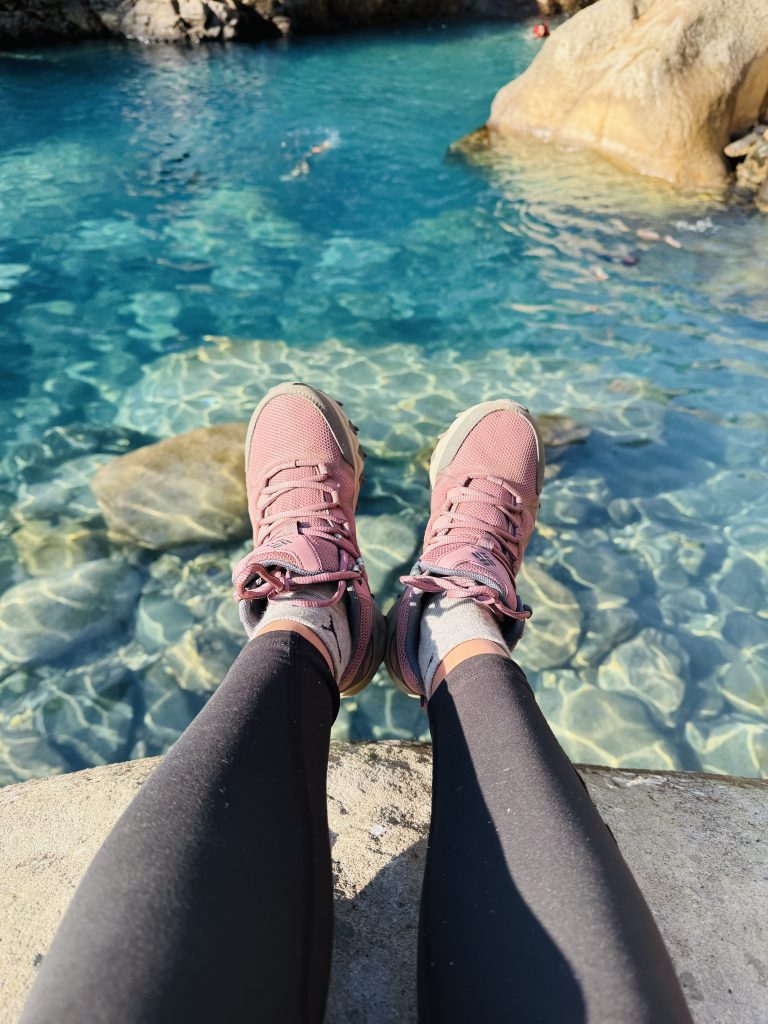
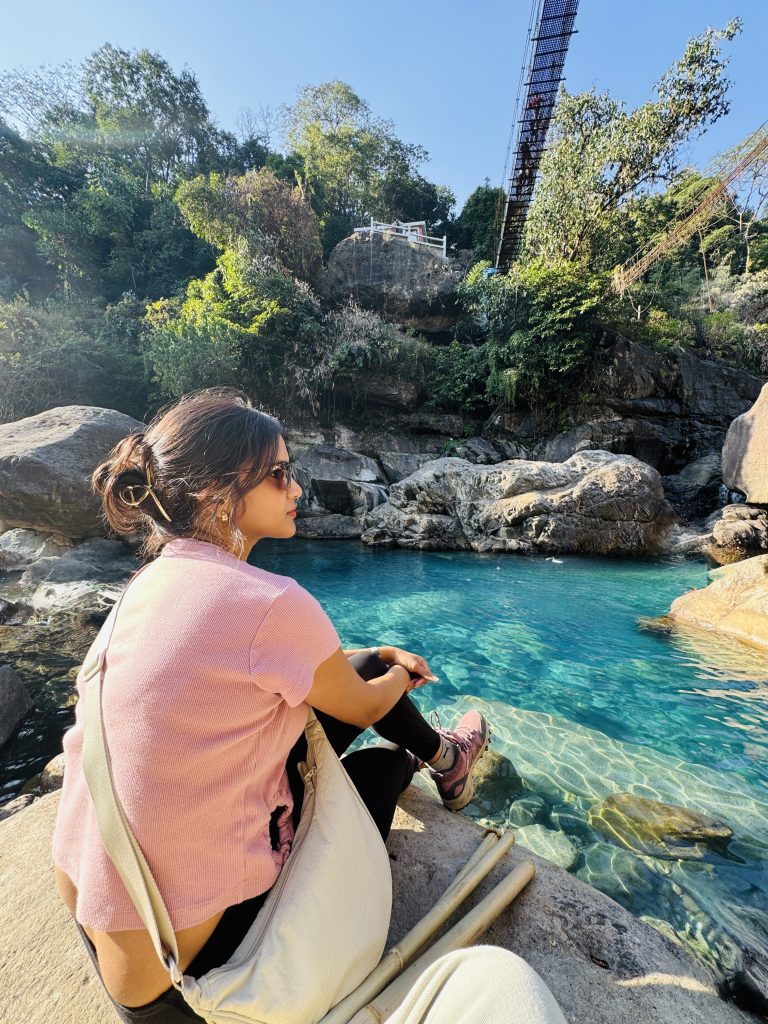
Single Root Bridge
From Nongriat, we trekked back 1,500 steps to a quieter spot featuring a Single Root Bridge. Entry costs Rs10 per head, and the lack of crowds made it feel more serene and magical. The surrounding natural beauty was unmatched, with towering mountains and lush greenery providing a perfect backdrop. Unlike Nongriat, there are no shops here making it perfect for peaceful reflection and embracing the calm.
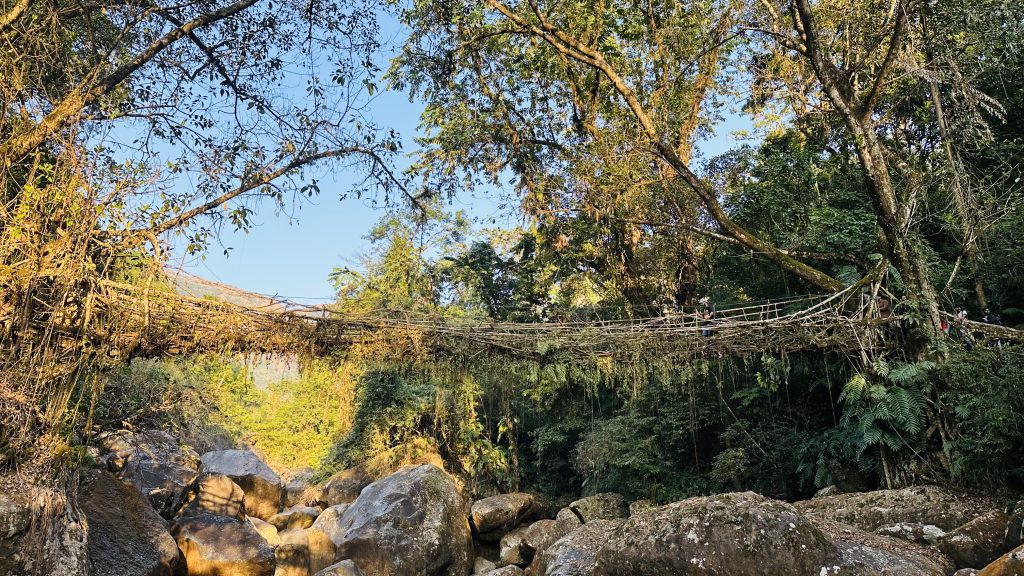
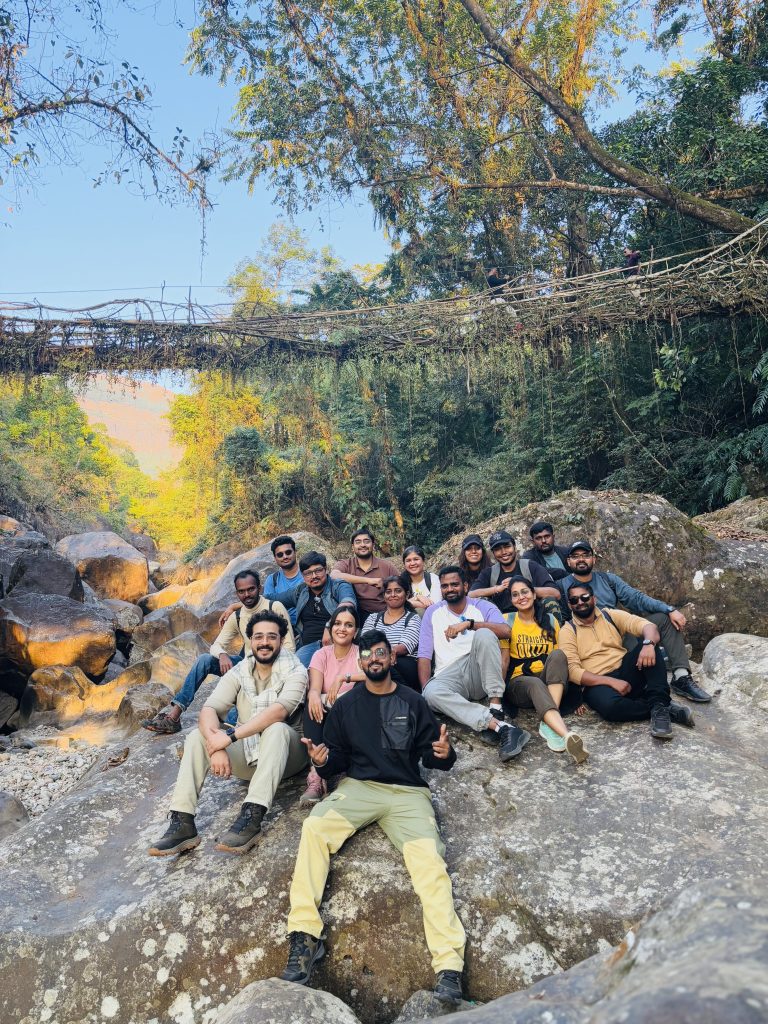
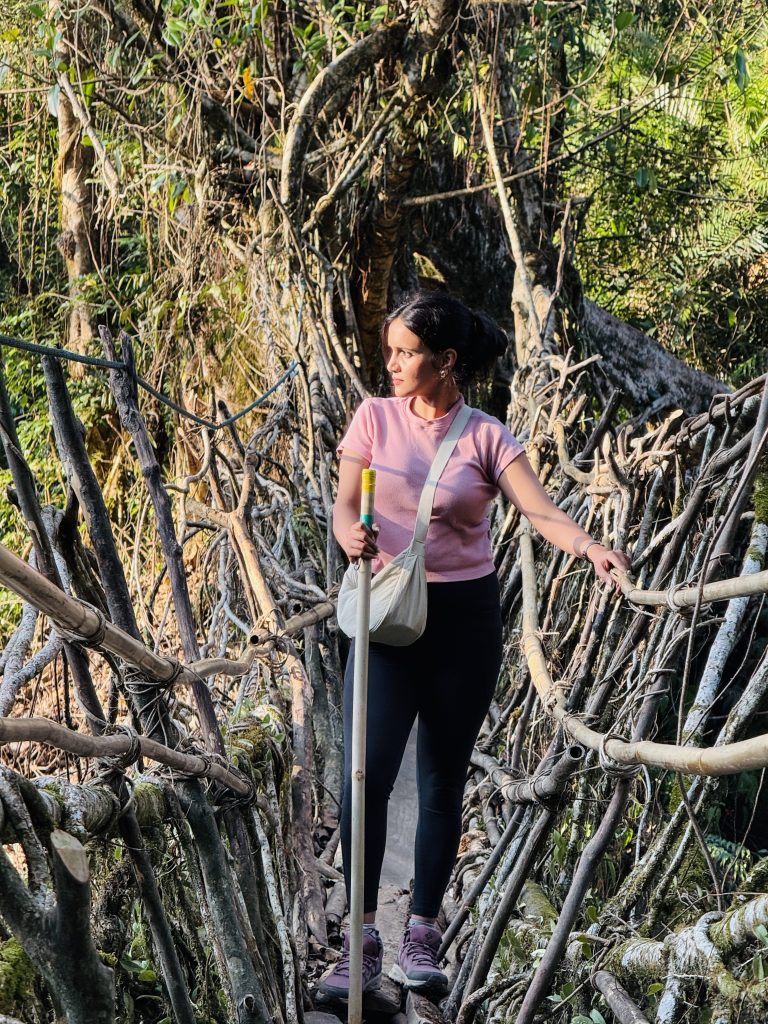
After resting and taking group photos, we began the most gruelling part of the trek: climbing back up the steep 2,000+ steps. Everyone took the ascent at their own pace, and with determination, we finally made it to the top.
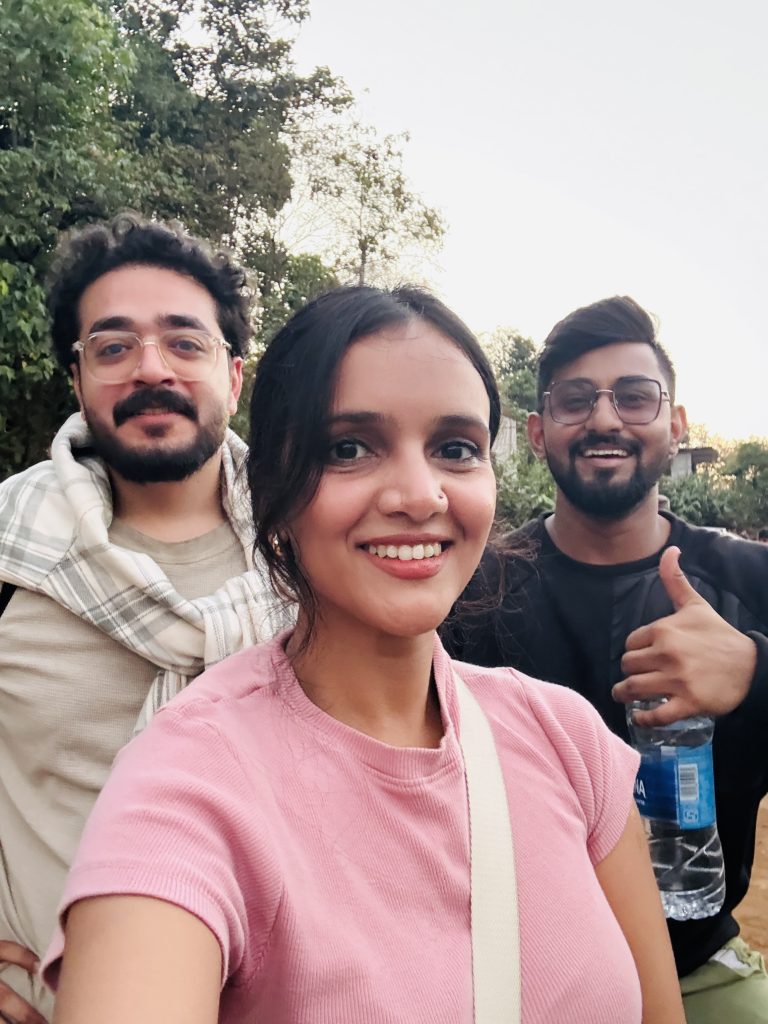
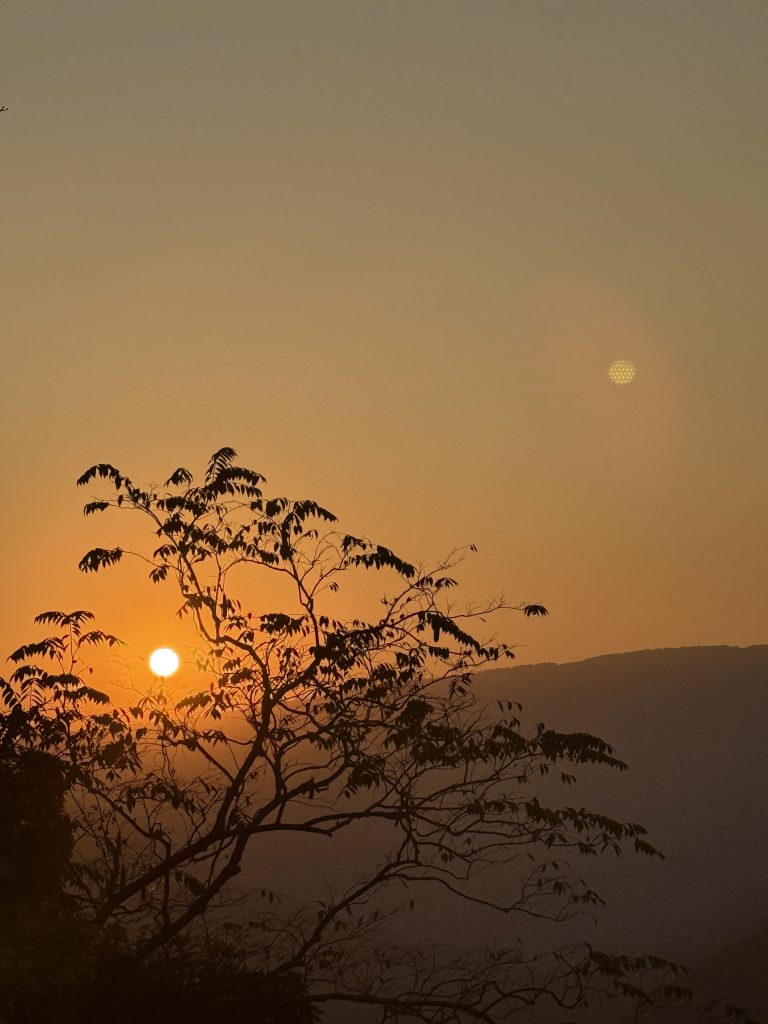
At the entrance, a small shop offered freshly made sandwiches, which were a much-needed treat after the tiring hike. We then headed back to our homestay in Cherrapunji, where we relaxed and reminisced about the incredible day.
Day 4: Chasing Wonders, One Step at a Time
Arwah Caves
We started the day by exploring the fascinating Arwah Caves, just 20 minutes from our Cherrapunji stay. These limestone caves, carved by nature over centuries, are wider and less claustrophobic than Mawsmai, making them an excellent spot for leisurely exploration. As we carefully observed the cave walls, we spotted ancient marine fossils—a glimpse into Meghalaya’s prehistoric past. The area around the caves offer stunning canyon views perfect for photography. The entry fee is Rs20 per head & timings are 9:30 AM to 5:30 PM
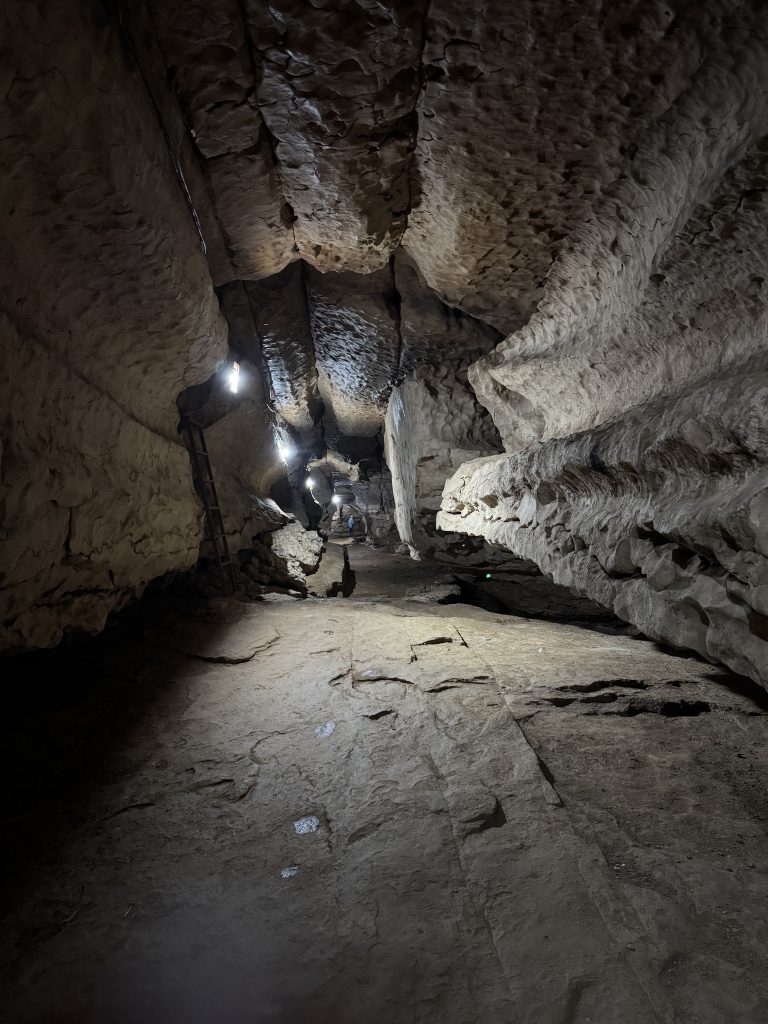
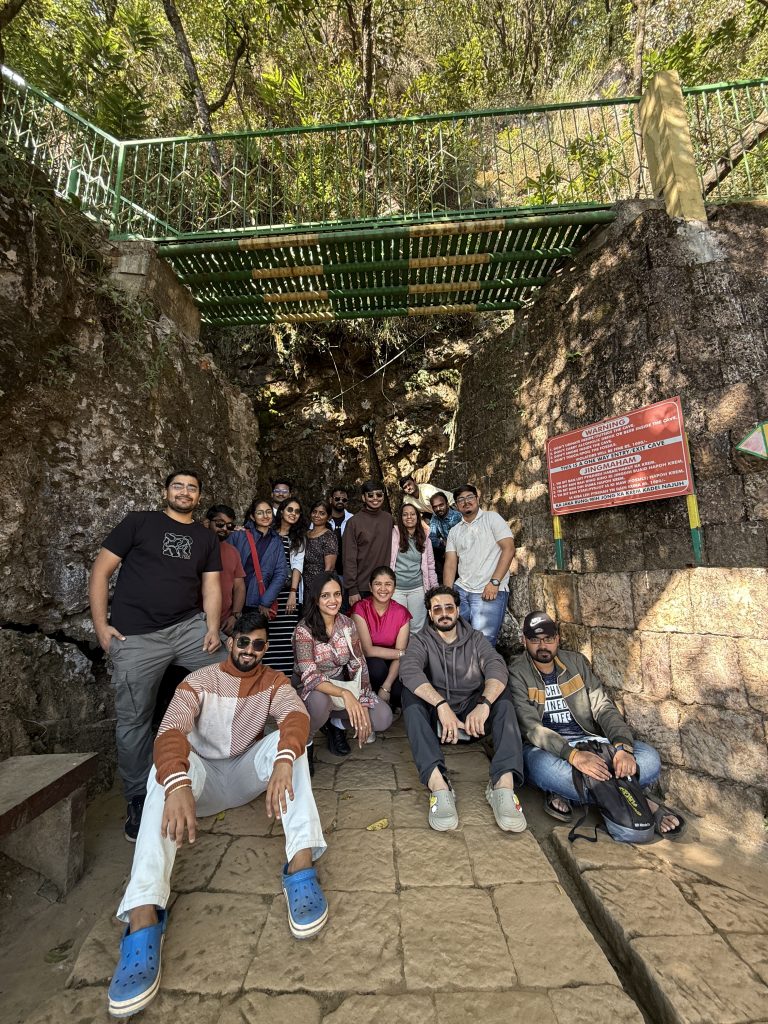
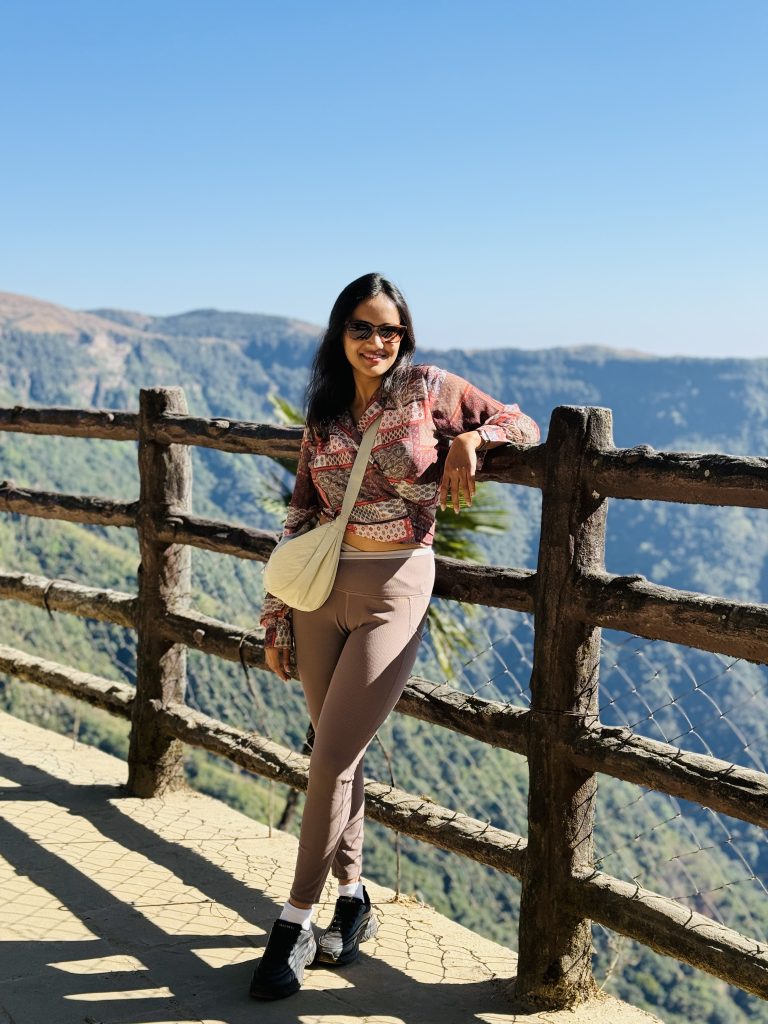
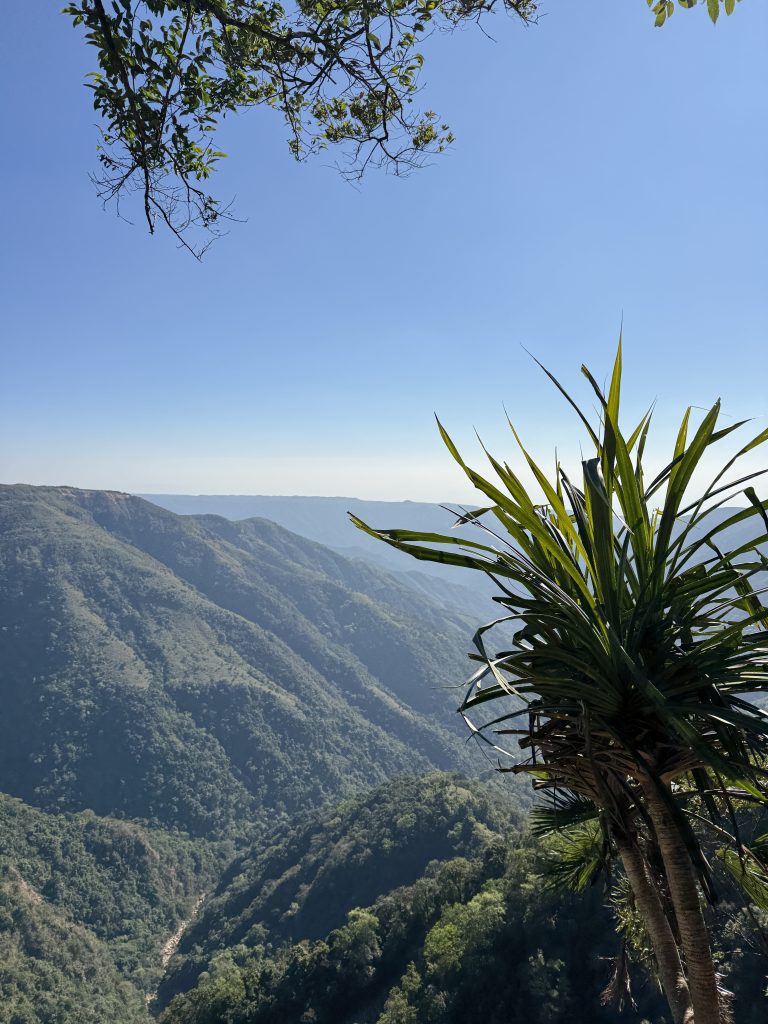
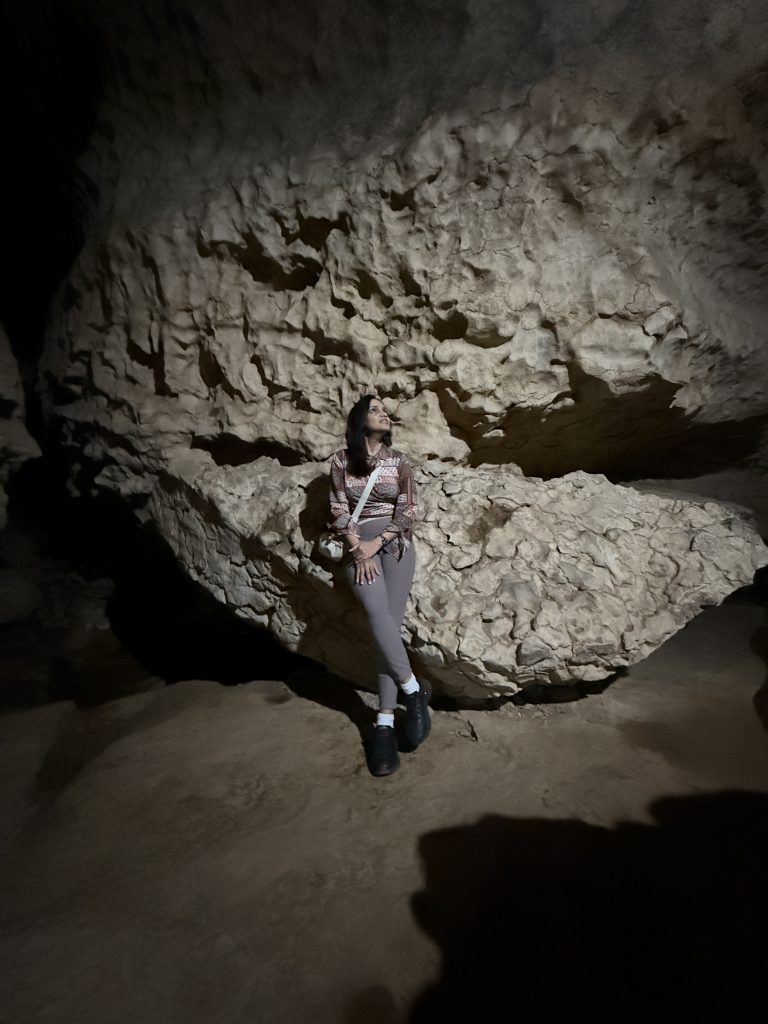
Nohkalikai Falls
After a short 18-minute, 6 km drive from Arwah Caves, we reached the iconic Nohkalikai Falls, the tallest plunge waterfall in India. With its 340-meter vertical drop, this awe-inspiring natural marvel is surrounded by vibrant red-rock cliffs cloaked in lush greenery. The water cascades dramatically into a turquoise pool, creating a scene so breathtaking it feels almost surreal.
As we stood at the viewpoint, soaking in the grandeur of Nohkalikai, our guide shared the tragic legend behind its name. In Khasi, Nohkalikai translates to ‘Jump of Likai’, where Noh means ‘jump’, Ka is a prefix for women, and Likai was a local Khasi woman. This story adds a layer of depth to the already breathtaking setting, and you can read more about the fascinating legend in my detailed blog on Nohkalikai.
The viewpoint offers ample opportunities to soak in the panoramic views and capture the grandeur of the falls. Nearby, local shops sell souvenirs, bamboo crafts, and traditional Khasi trinkets. Remember to negotiate prices, as haggling is part of the shopping experience here.
For those seeking adventure, there is a steep trek leading to the base of the falls, providing a unique perspective. However, this trek is challenging and time-intensive, so we opted to continue our journey after soaking in the splendor from above.
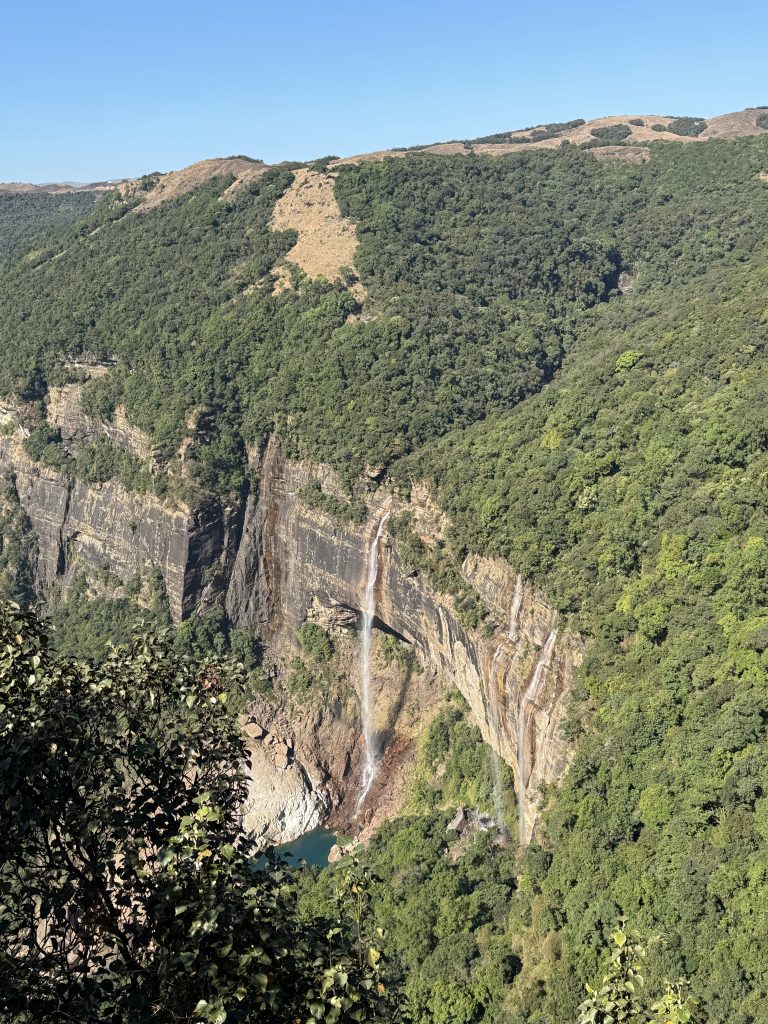
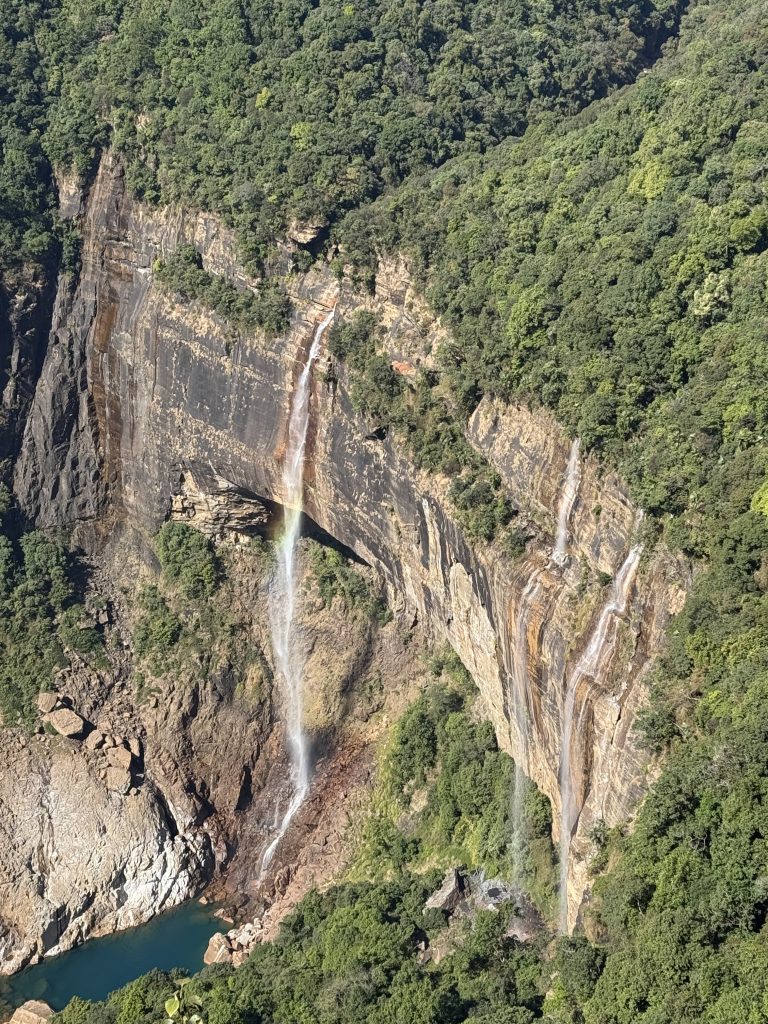
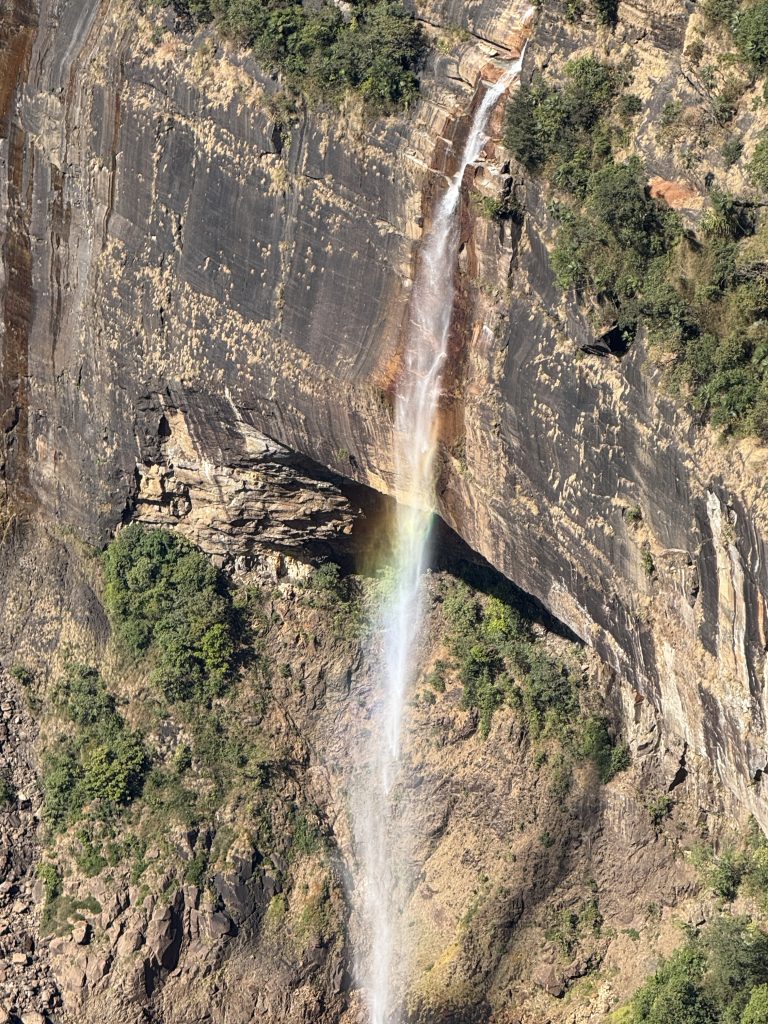
Lunch at Orange Roots
We stopped at Orange Roots, a popular vegetarian restaurant on the Sohra-Shella Road. The food was a delight—dosas, thalis, and mouthwatering desserts like gulab jamun and rasgulla. This place is a must-visit for anyone in Cherrapunji.
Lyngksiar Falls
Our final stop was the serene Lyngksiar Falls, about 20 km (40 minutes) from Nohkalikai. While it may not be the tallest or most famous waterfall, its peaceful surroundings made it the perfect retreat.
Most of us couldn’t resist the crystal-clear, icy water and enjoyed a refreshing dip, swimming toward the source of the falls. It was a group bonding experience we’ll never forget. After warming up with tea at a nearby shop, we began our journey to Shillong, a 2-hour drive, where we ended the day reminiscing about the wonders we had witnessed.
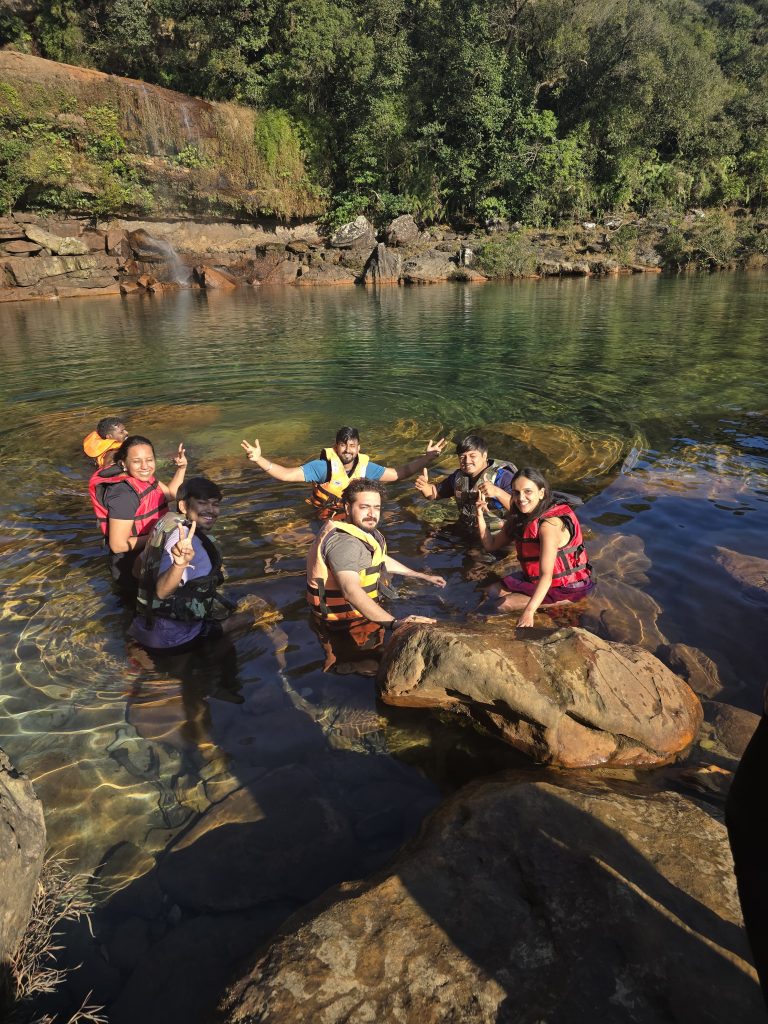
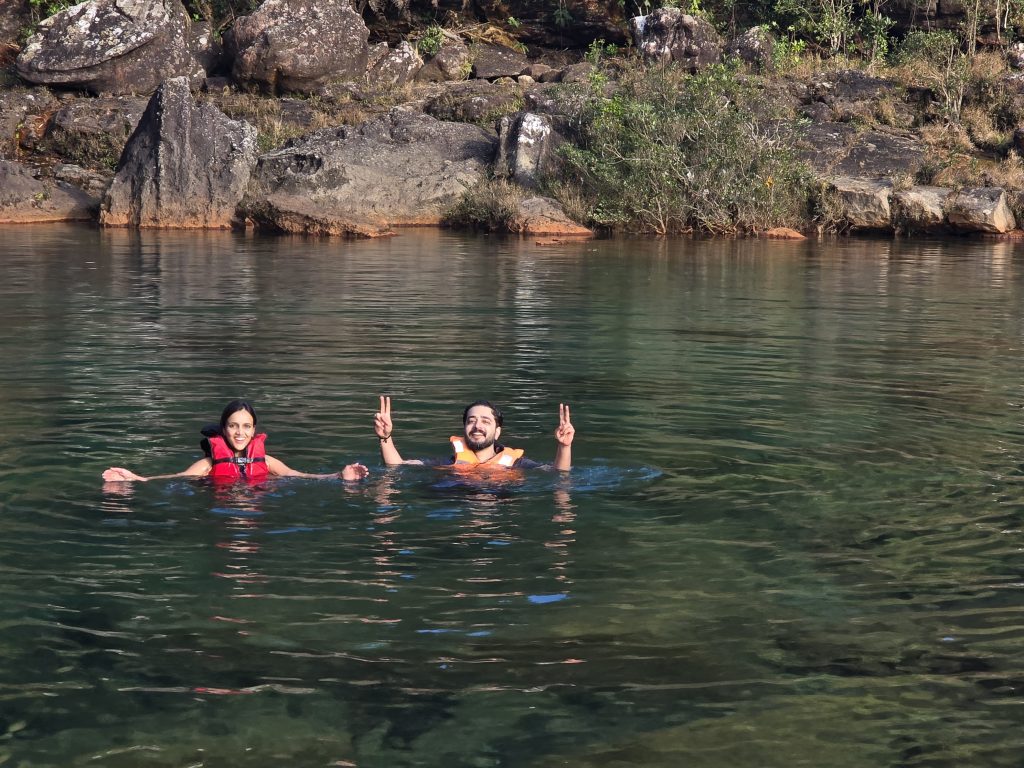
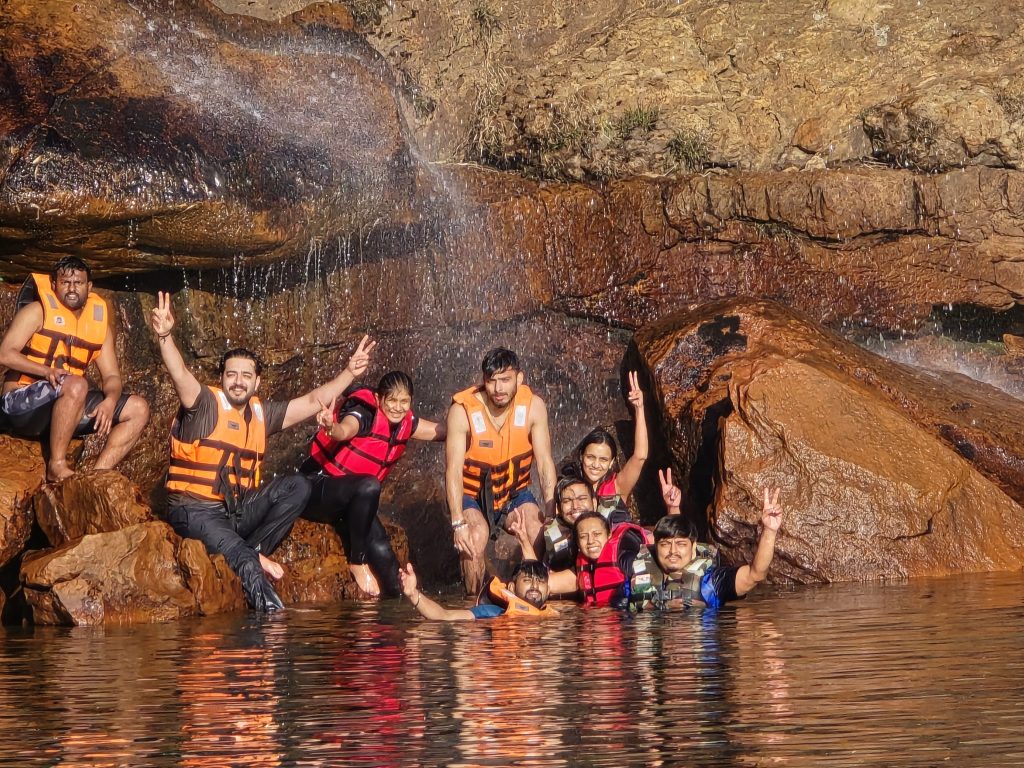
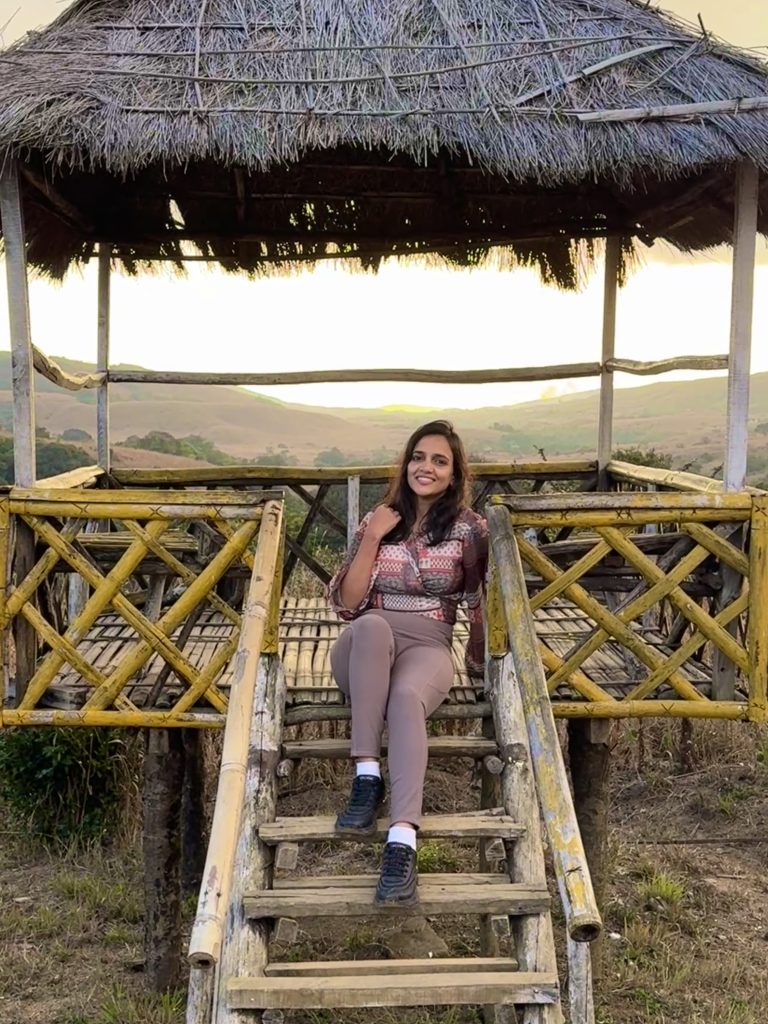
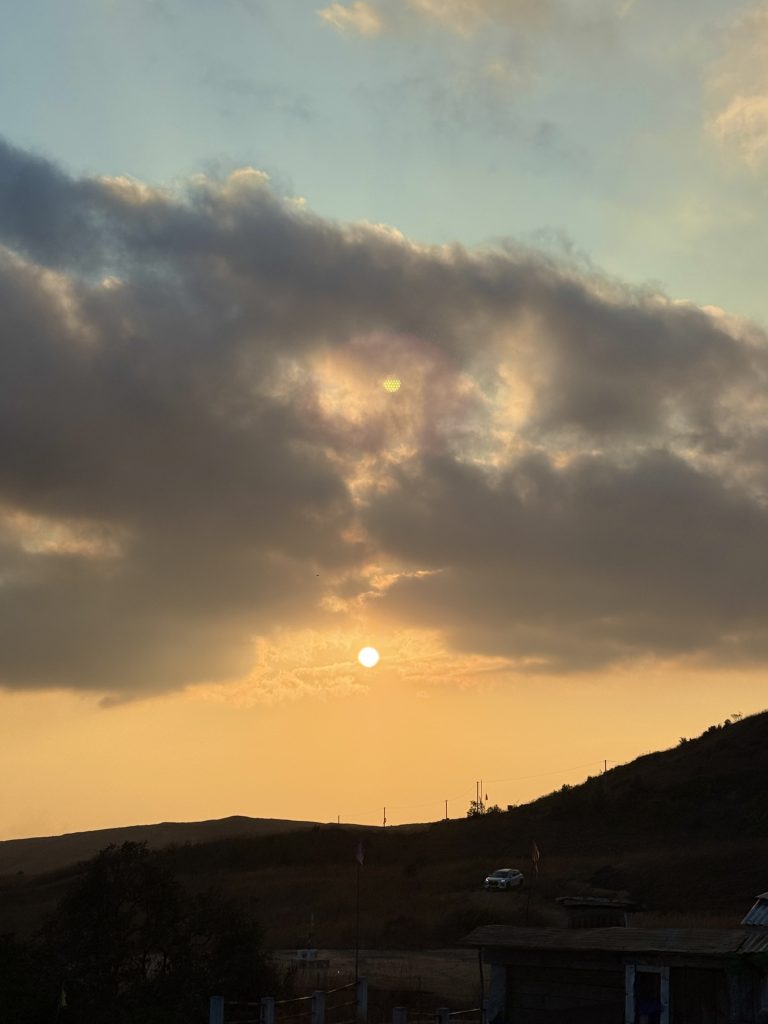
Day 5: Bidding Farewell, Leaving With Memories
Umiam Lake
The last day of our Meghalaya trip started with packing up and a stop at the stunning Umiam Lake, just 16 km from Shillong. A popular Meghalaya tourist spot, this vast man-made reservoir was created in the early 1960s. It looked like a natural wonder, with its calm waters framed by the surrounding hills.
We spent the morning enjoying the scenery, taking photos, and engaging in activities like paddle boating and speed boating (available at minimal charges). The lake offered a peaceful atmosphere, perfect for reflecting on the trip.
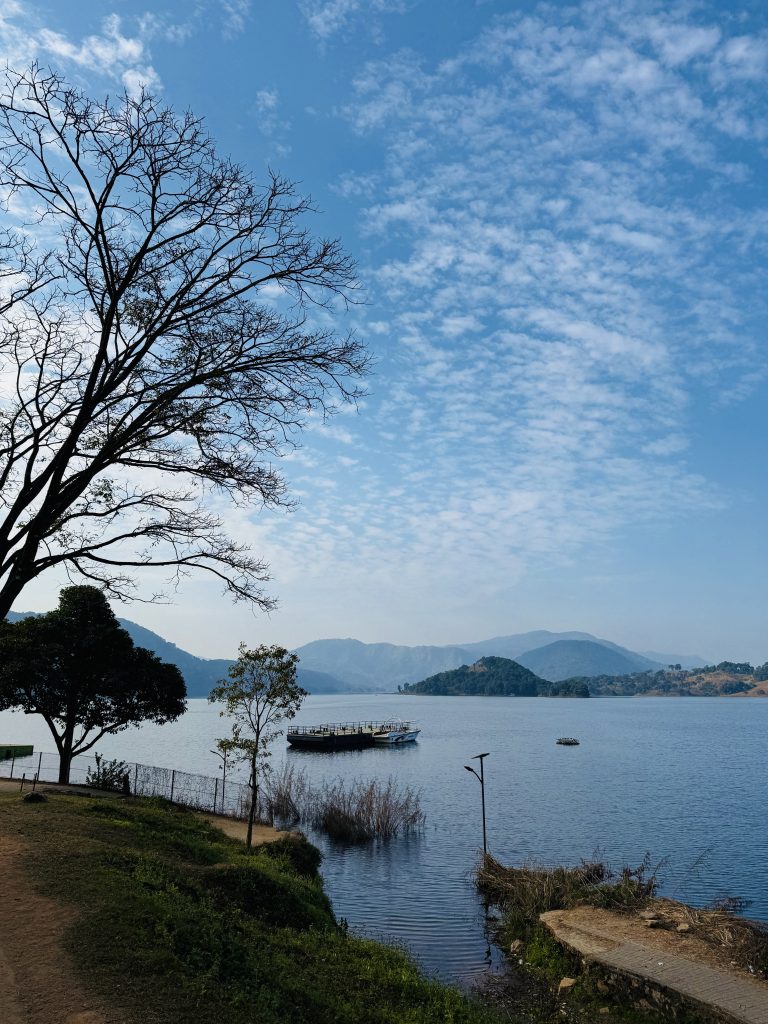
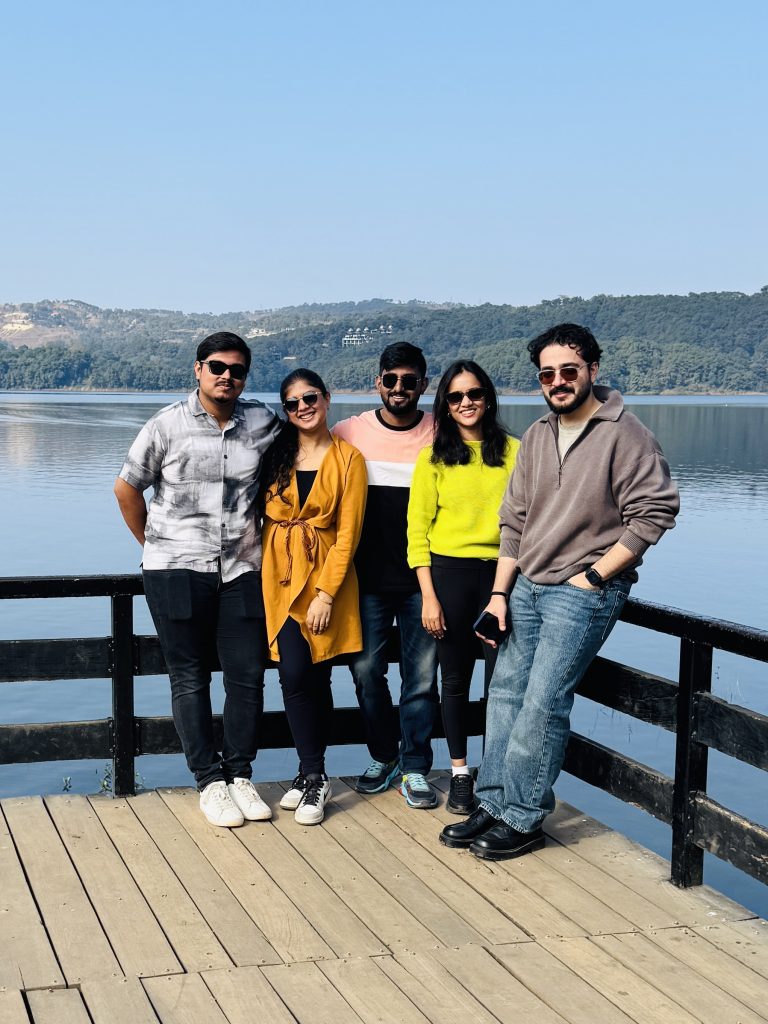
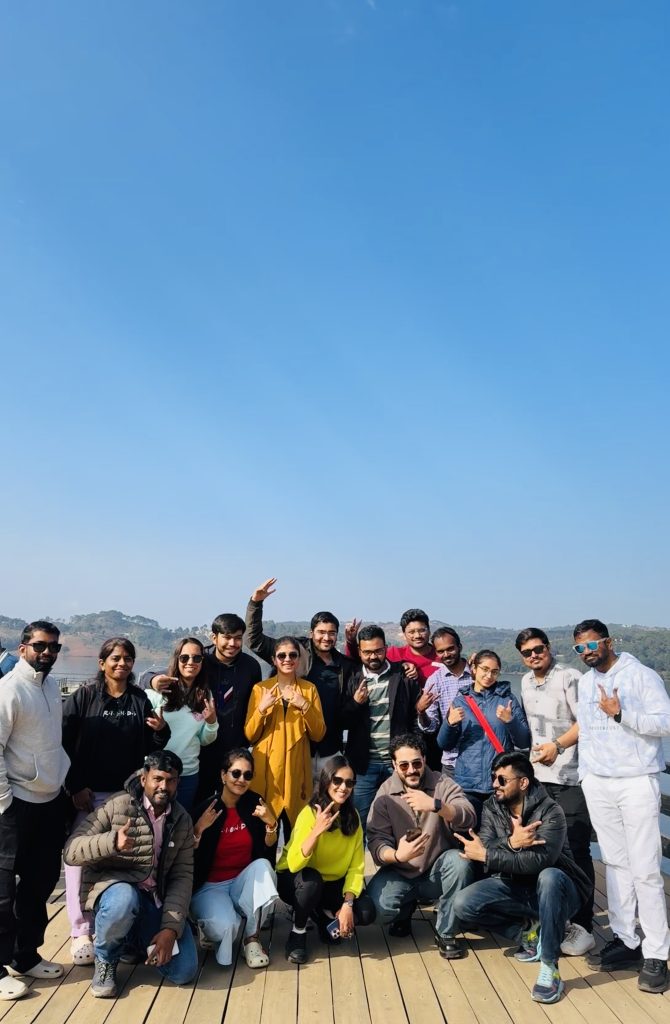
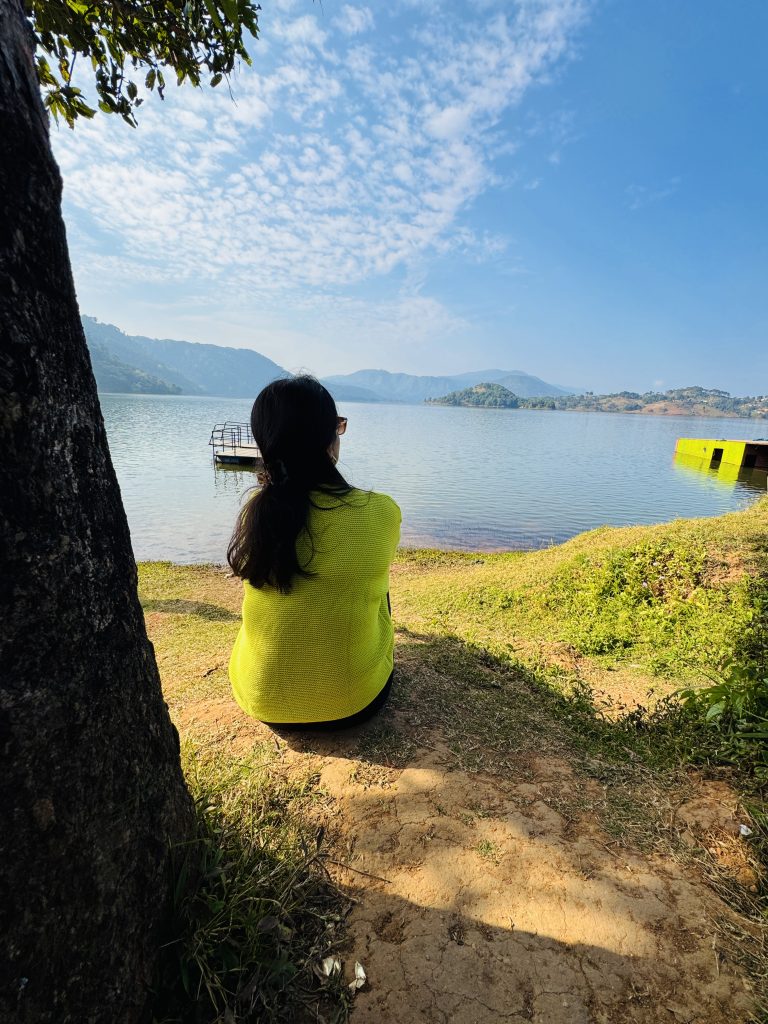
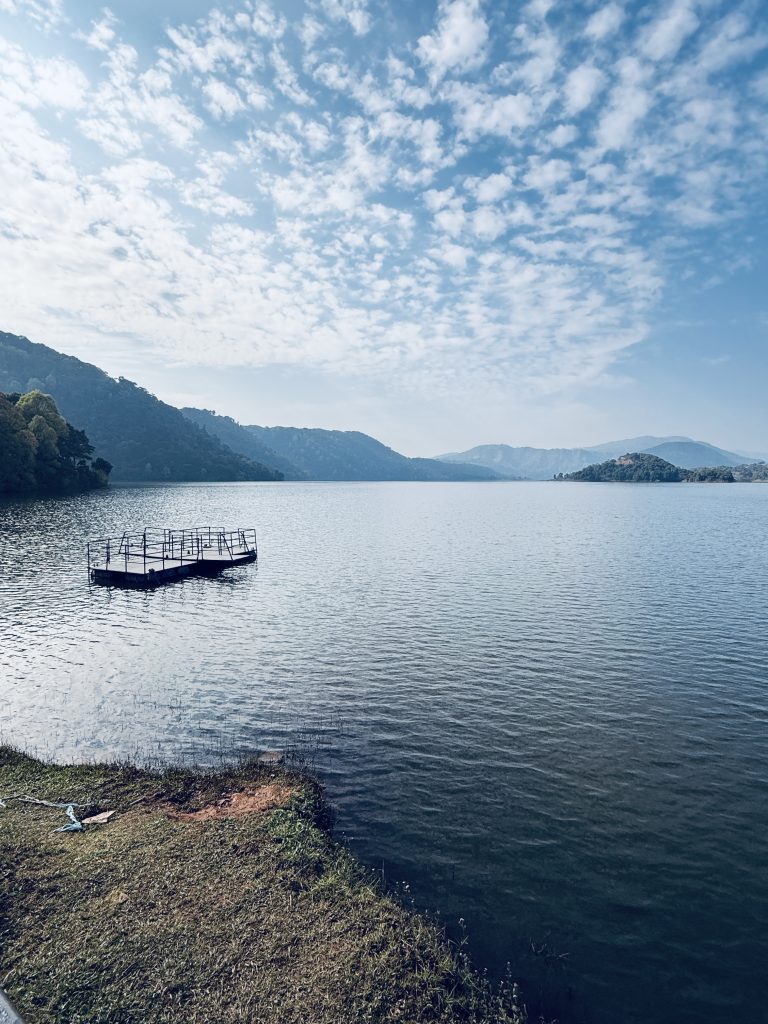
The group made the most of this final day, playing games, dancing in the gardens, and soaking in the sunshine. It was the perfect way to celebrate the friendships and memories we had built over the past few days.
Return to Guwahati
By noon, we began the 2.5-hour drive to Guwahati, reaching by 3 PM. After heartfelt goodbyes, we headed to the airport for our respective flights, carrying with us unforgettable memories of Meghalaya’s breathtaking landscapes and vibrant culture.
Where to Stay in Meghalaya?
These were the accommodations arranged by WanderOn for the trip, and I found them to be clean and comfortable. However, feel free to explore and choose stays that align with your preferences and budget.
- Shillong (2 Nights) – Alpine Continental
- Shnongpdeng (1 Night) – Frank Camping
- Cherrapunji (2 Nights) – Sa-i-Mike Resort
Meghalaya Trip essentials
- Carry a poncho or waterproof jacket for sudden rain.
- Bring enough cash for remote areas where digital payments aren’t accepted.
- Wear sturdy, comfortable shoes for trekking and exploration.
- Pack light layers for chilly evenings, even in summer.
- Pack a torch or flashlight for treks as some areas have limited lighting.
- Apply sunscreen and carry sunglasses for daytime activities.
- Keep surroundings clean by carrying a trash bag for waste.
- Respect local culture and ask permission before photographing locals.
- Season specific reminders:
- In monsoon: Pack waterproof shoes and quick-dry clothes.
- In winter: Carry warm layers, moisturizer, and lip balm.
- In summer: Use insect repellent, light clothing, and a sun-hat is a must.
Best months to visit Meghalaya
Meghalaya enjoys a tropical climate, with each season offering a unique experience in this picturesque state. The best time to visit generally falls between October and March, during the winter months. However, the season you choose for your Meghalaya trip will depend on the activities and experiences you seek. Here’s a quick guide to help you decide.
Winter (October to March)
This is the most popular time to visit Meghalaya. The nights are cool, and the days are pleasant and warm, with little to no rainfall. Winter is perfect for outdoor activities like trekking, cave exploration, and water sports. A major highlight is the crystal-clear waters of the Umngot River, which are best witnessed during this season.
Summer (April to June)
Summers in Meghalaya are relatively mild compared to other parts of India, with temperatures ranging between 15-25°C. This is an excellent time for sightseeing, as the weather remains pleasant, and the landscapes are lush and green. If you prefer a quieter visit, summer is less crowded than winter.
Monsoon (July to September)
Meghalaya truly comes alive during the monsoon, earning its name as the “Abode of Clouds.” The rains transform the state into a verdant paradise, with roaring waterfalls and mist-covered hills. While this season is breathtakingly beautiful, it’s not ideal for trekking or water sports due to the heavy rainfall and slippery terrain. However, if you love rain-drenched landscapes and dramatic scenery, this is the time for you.
No matter when you choose to visit, Meghalaya promises an unforgettable experience tailored to your preferences.



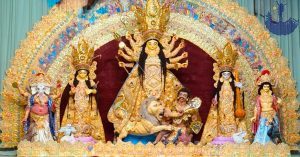
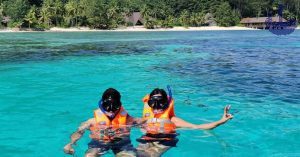
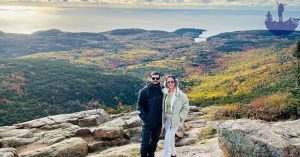
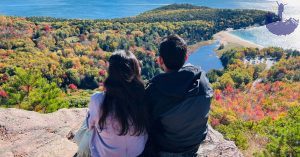

One Response
I really liked your itinerary. Would love to go on a trip to Meghalaya.